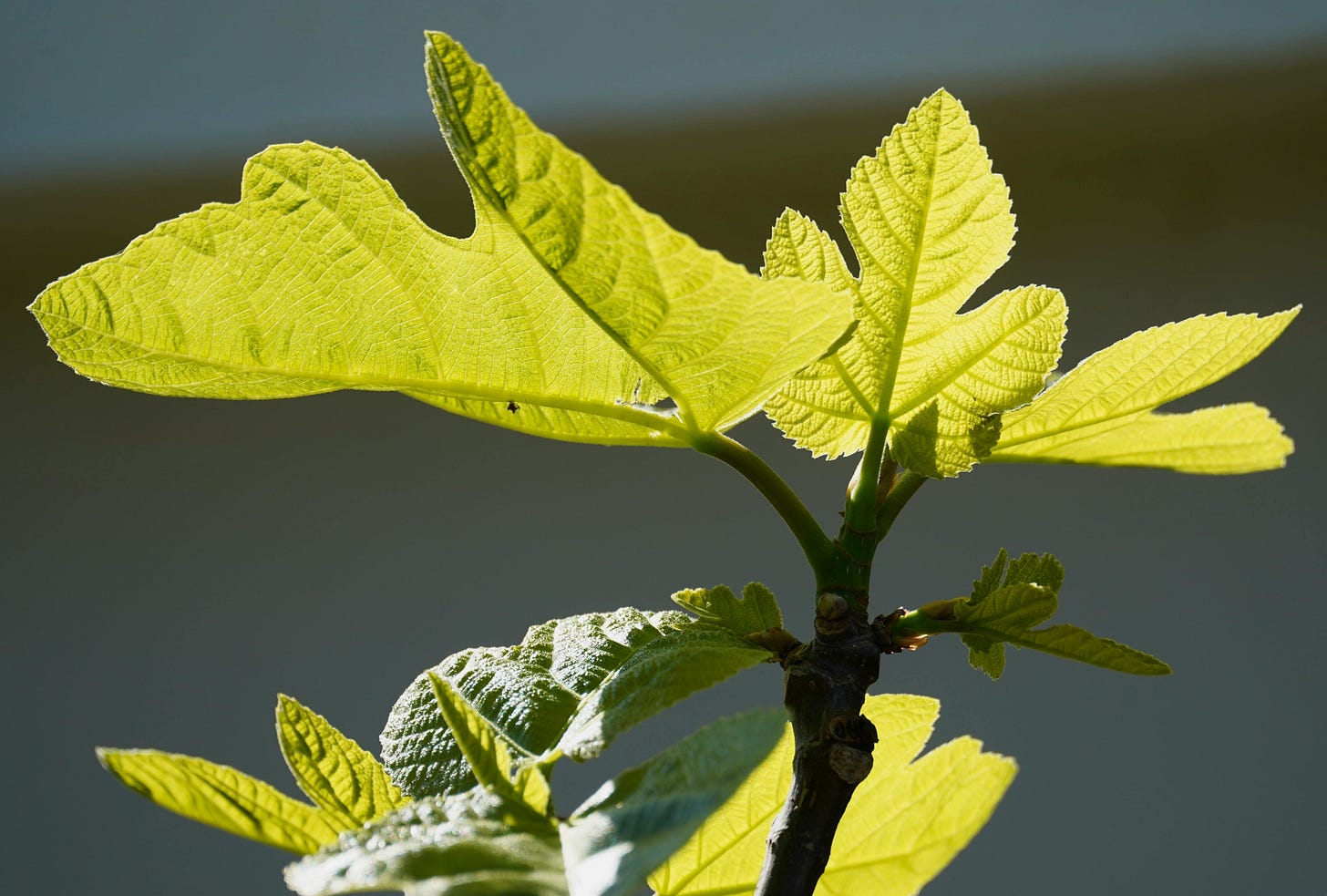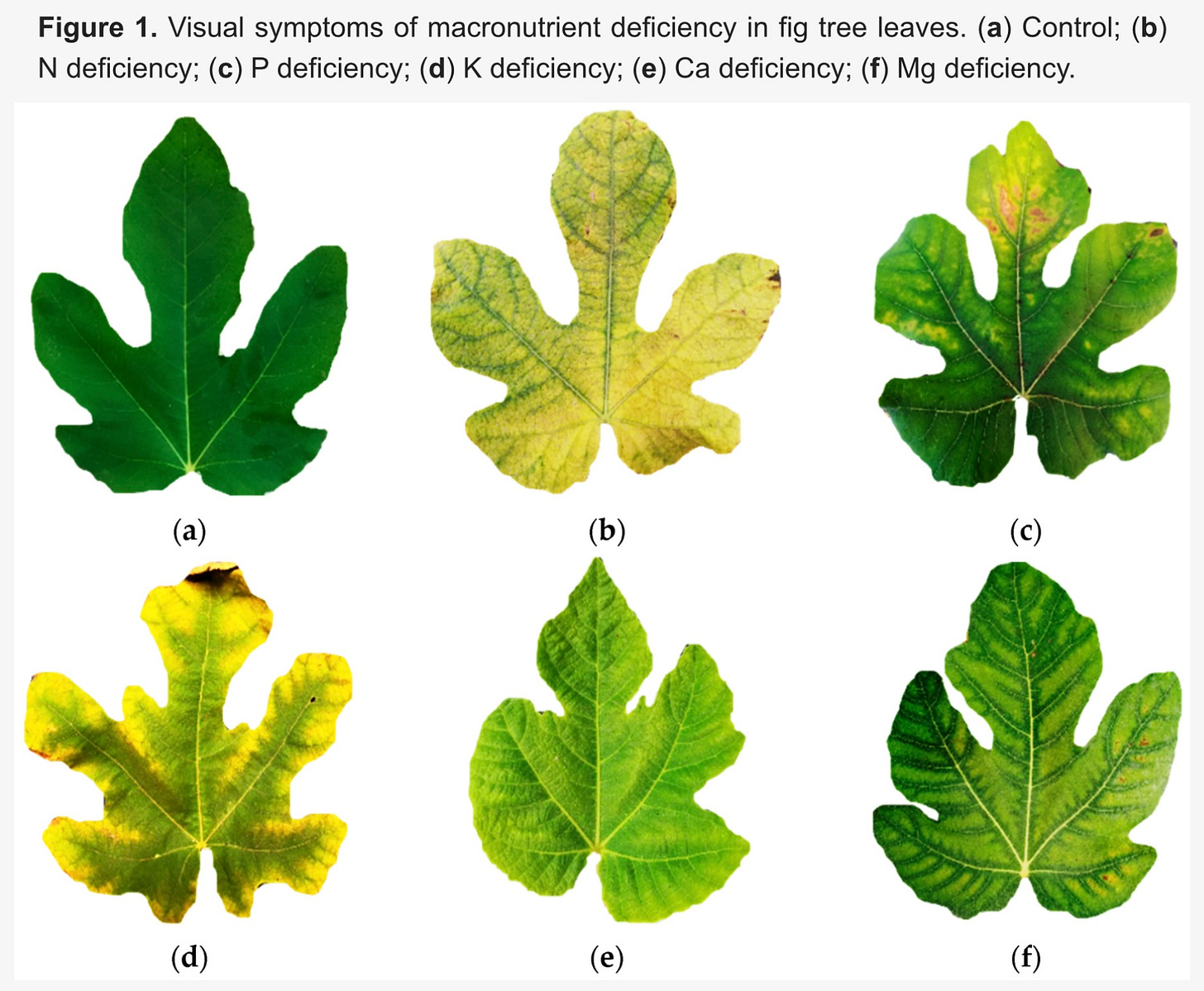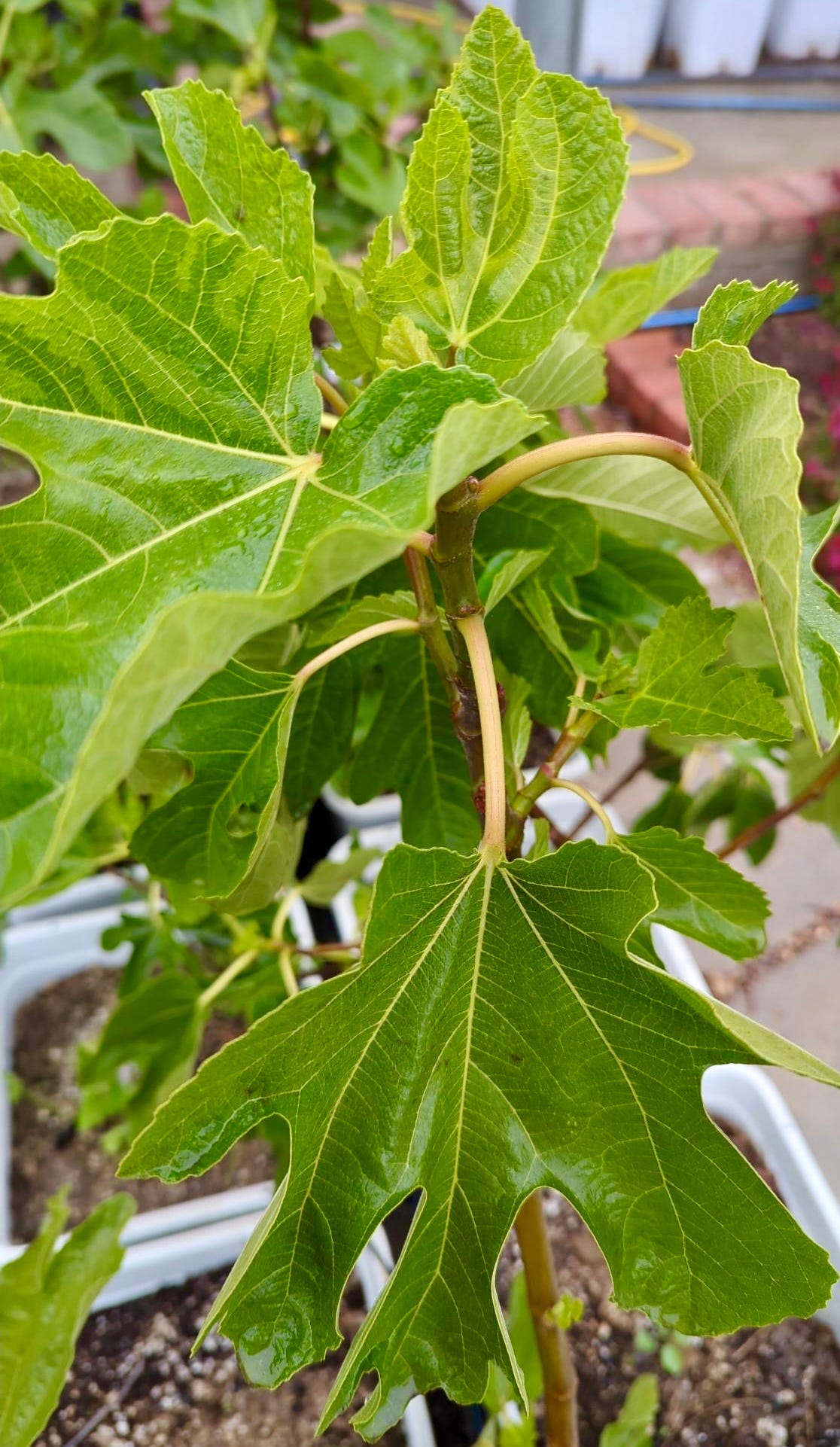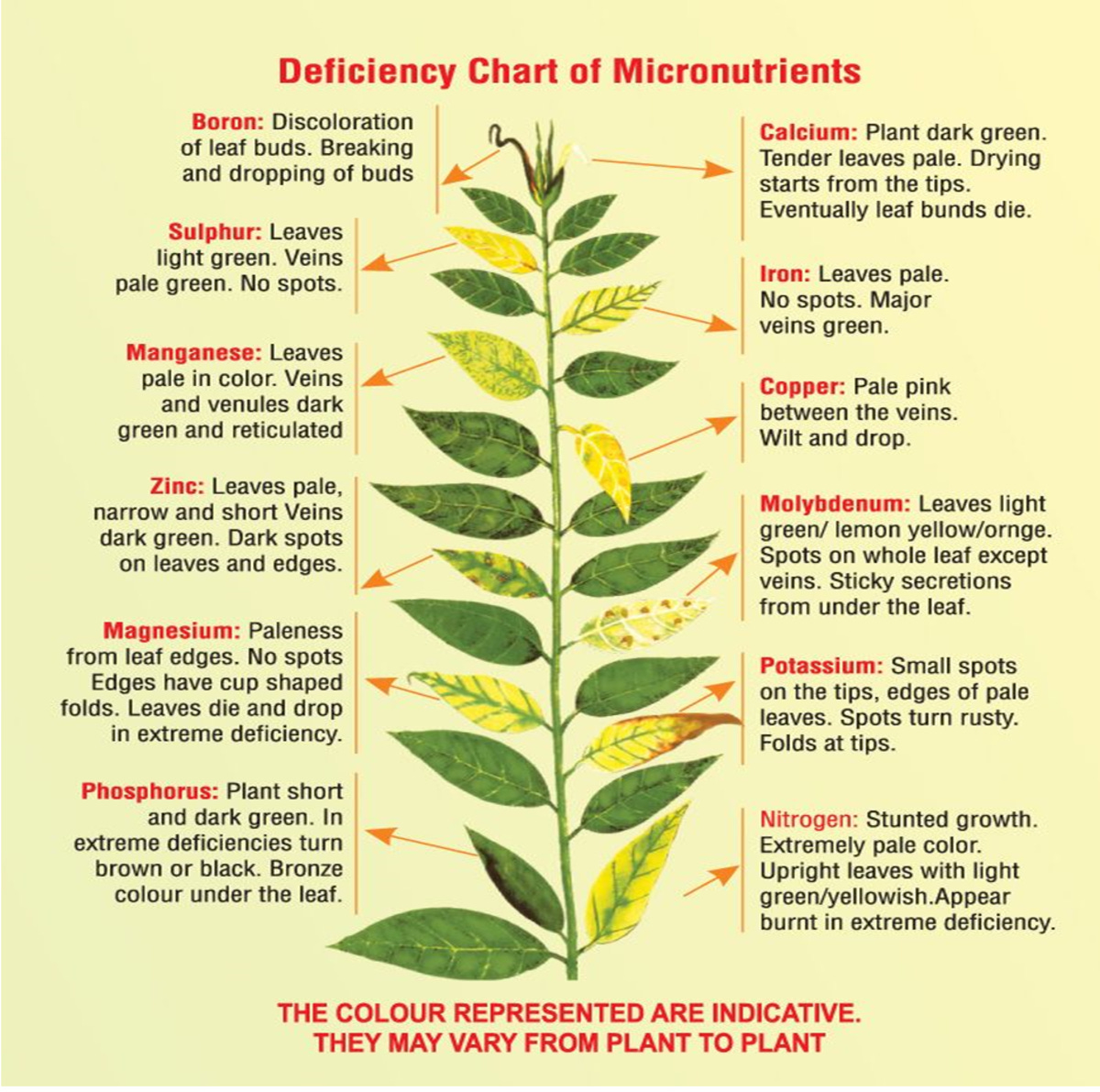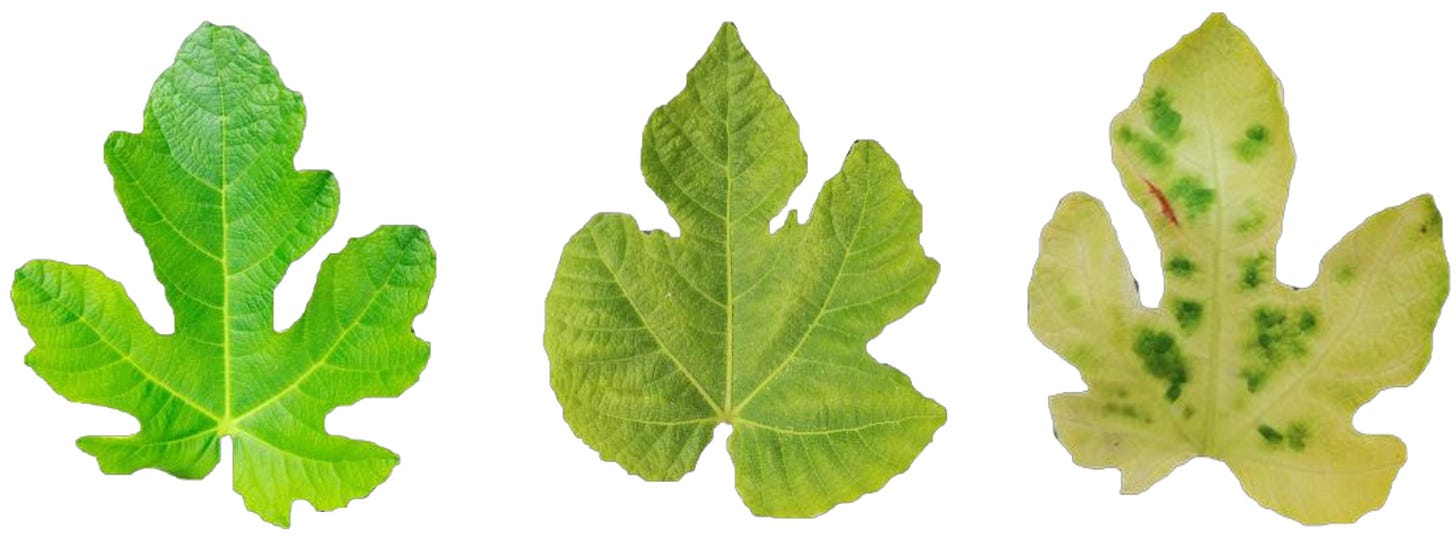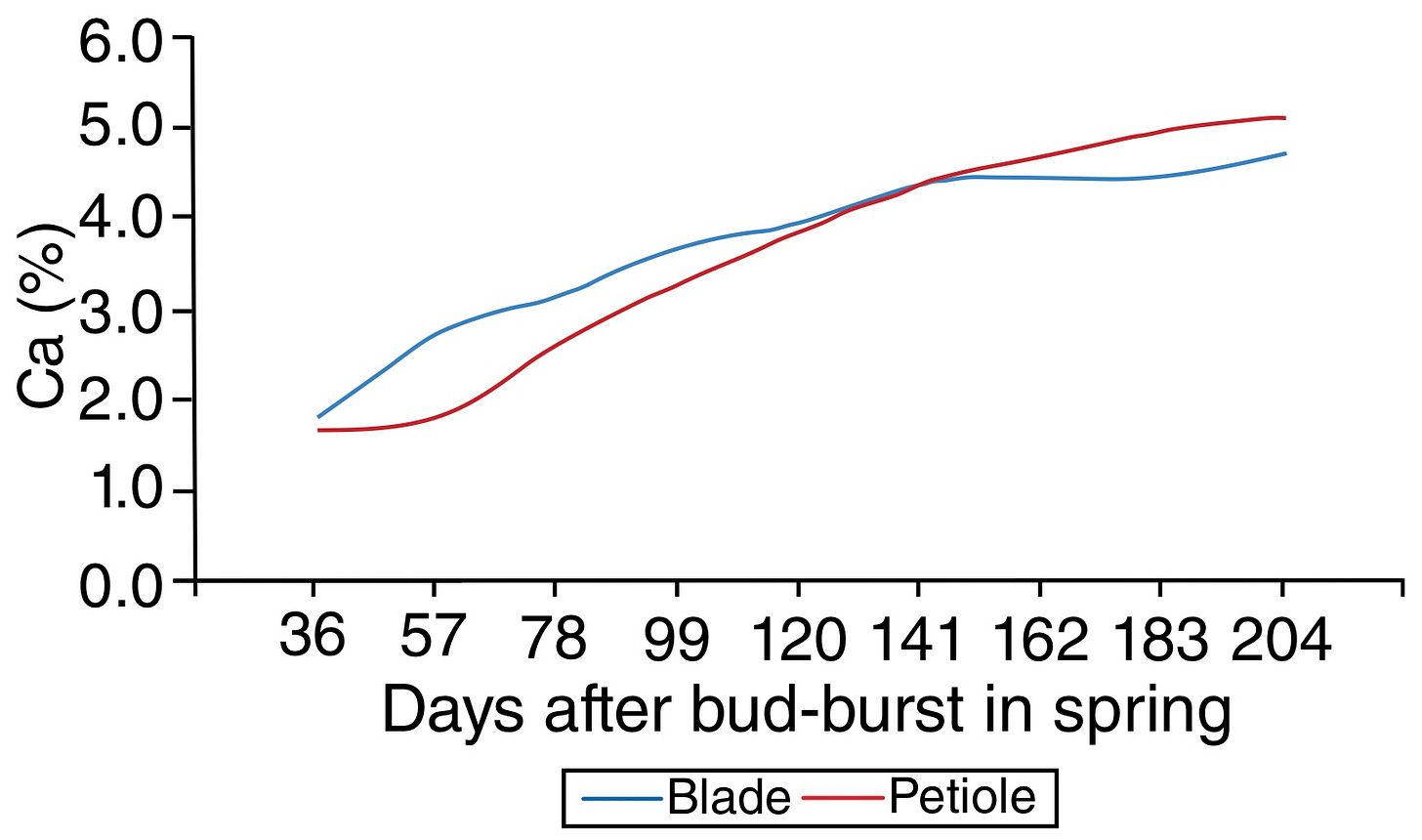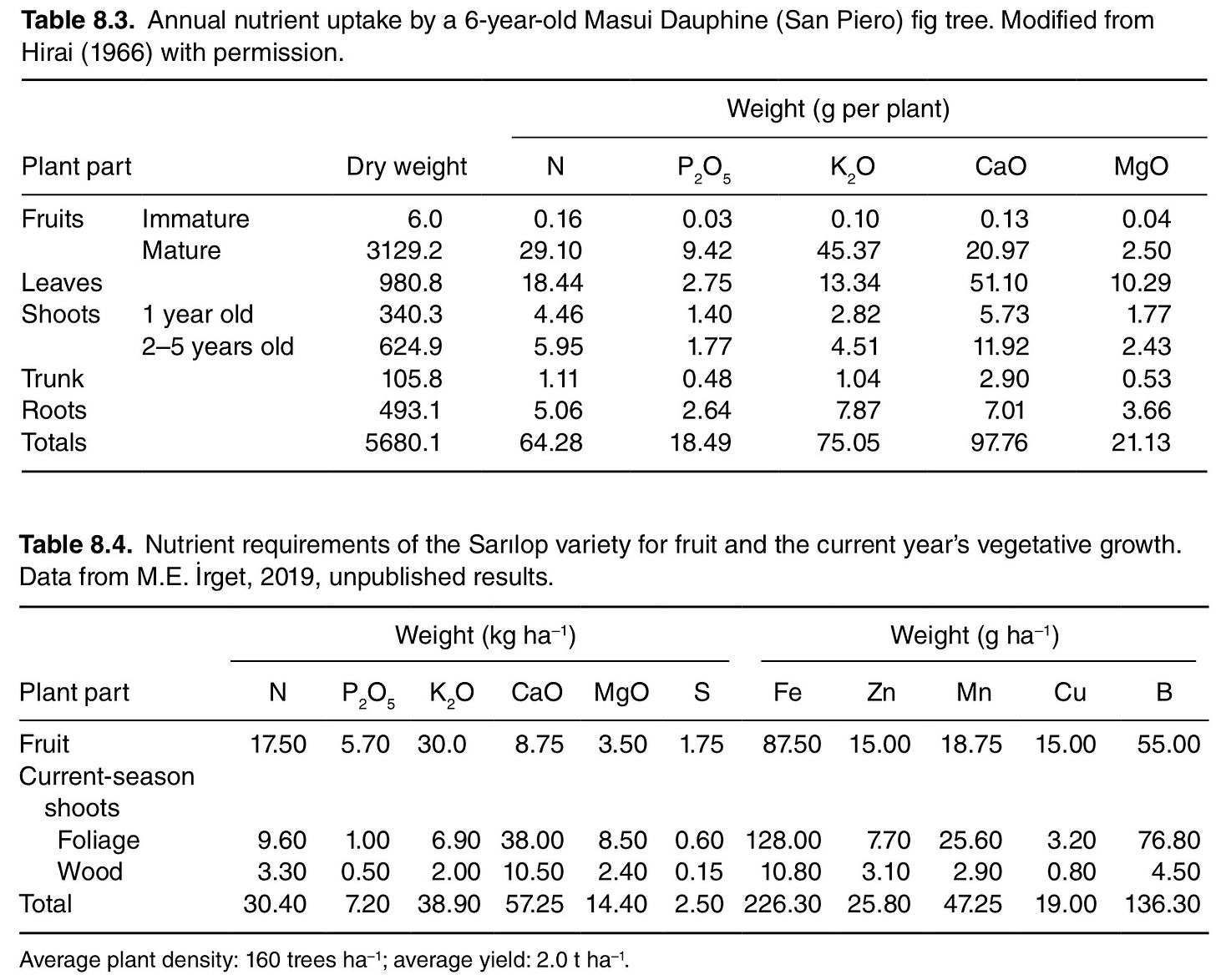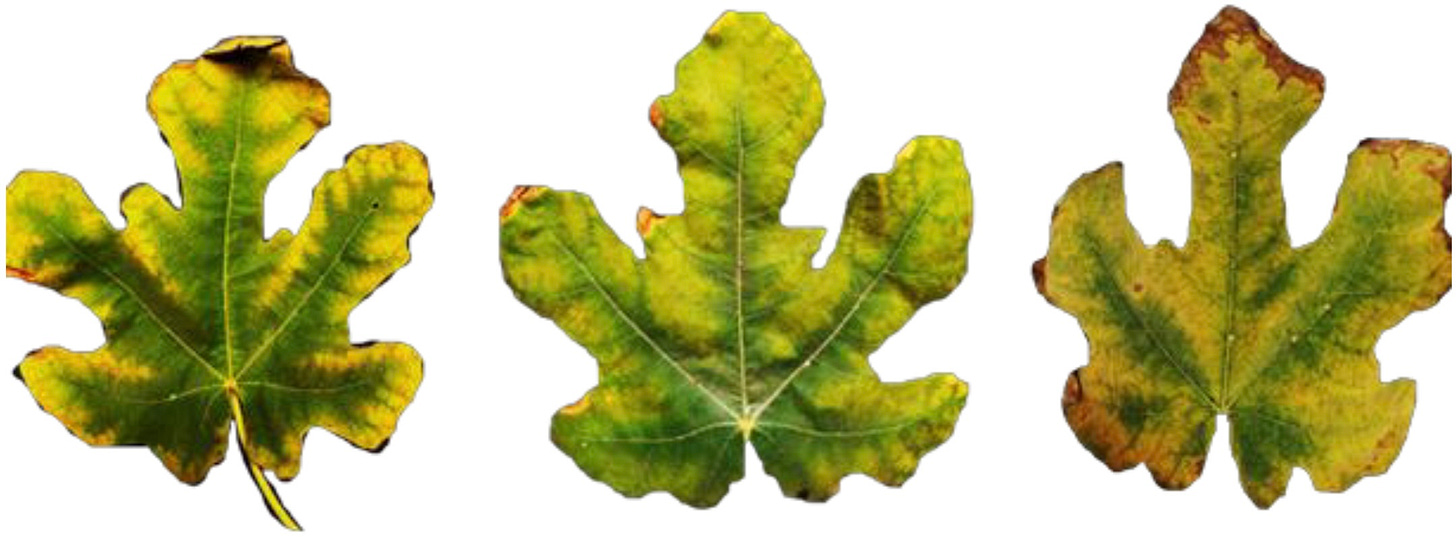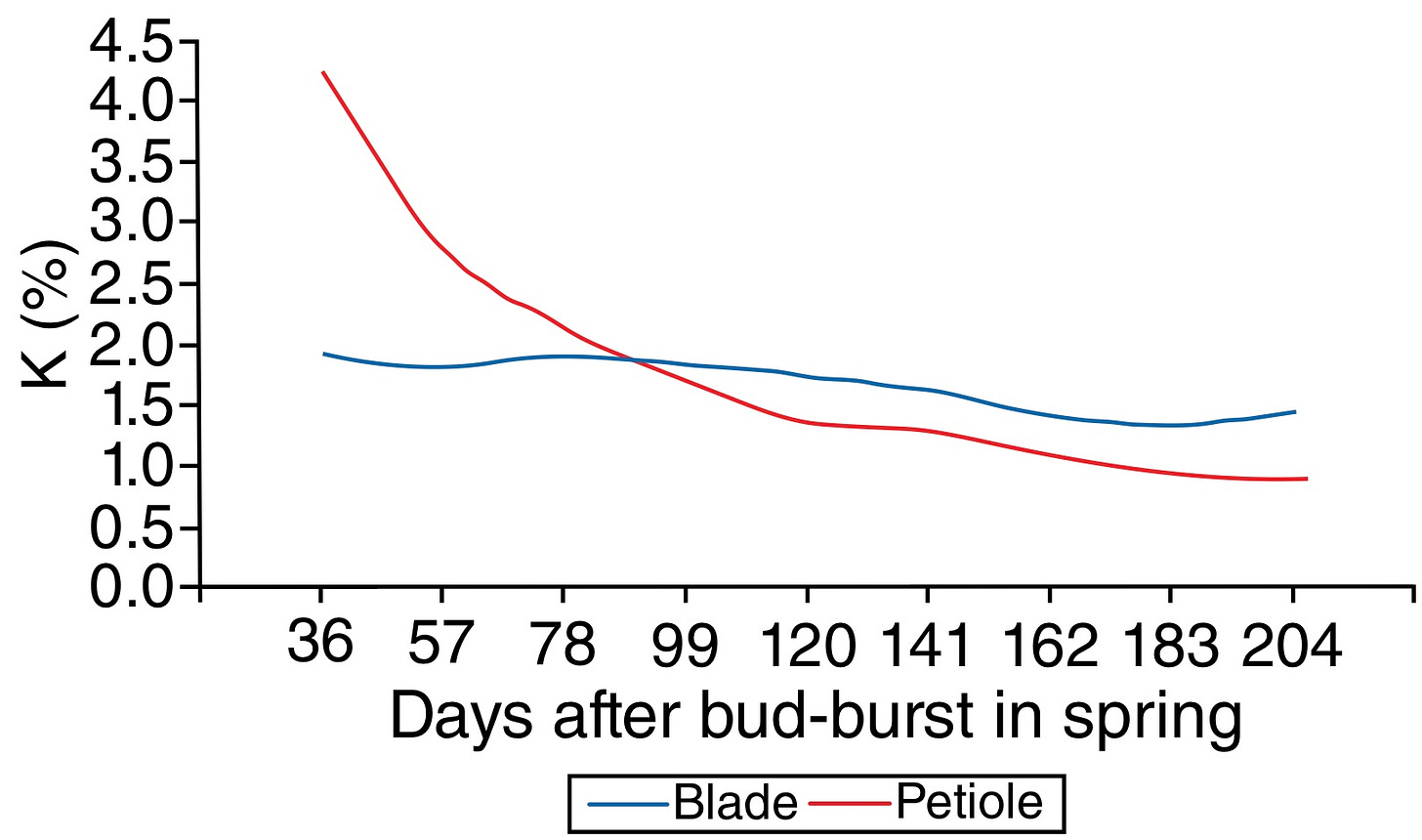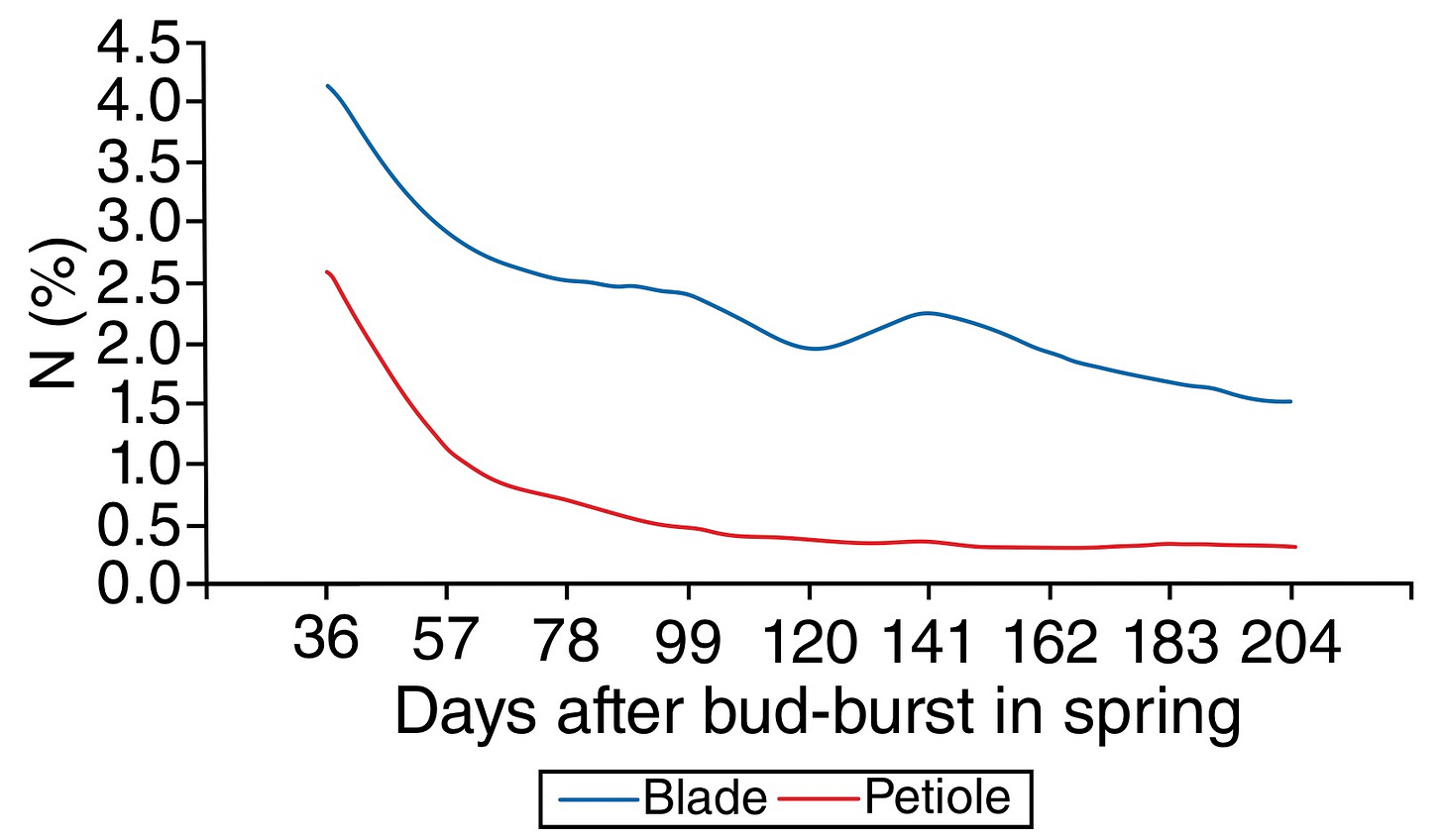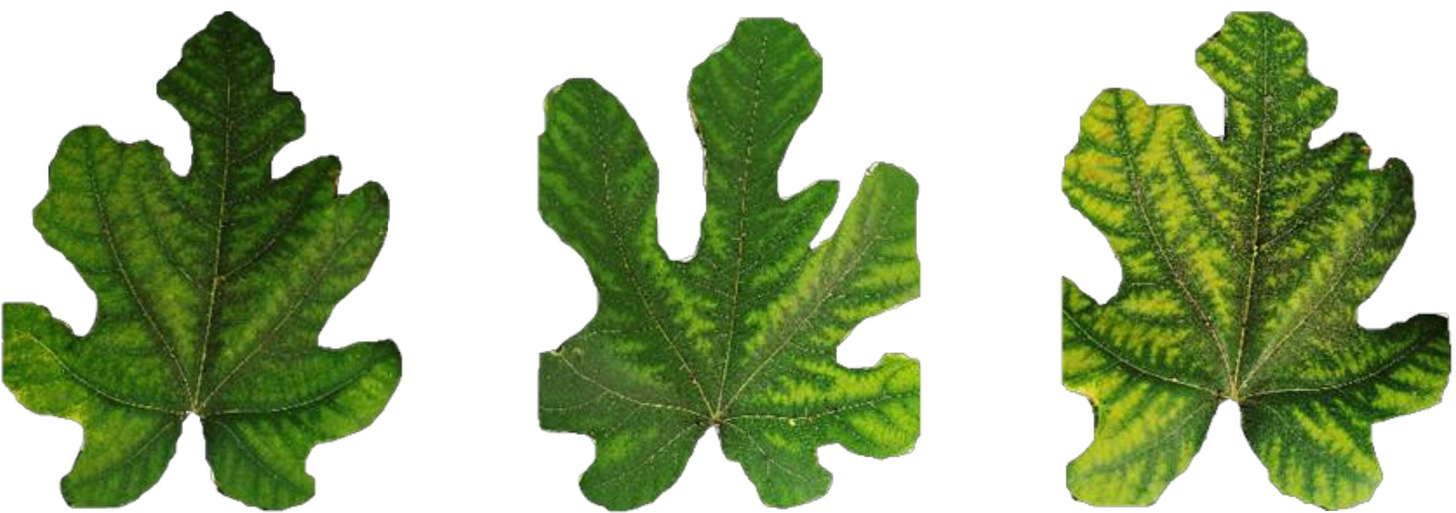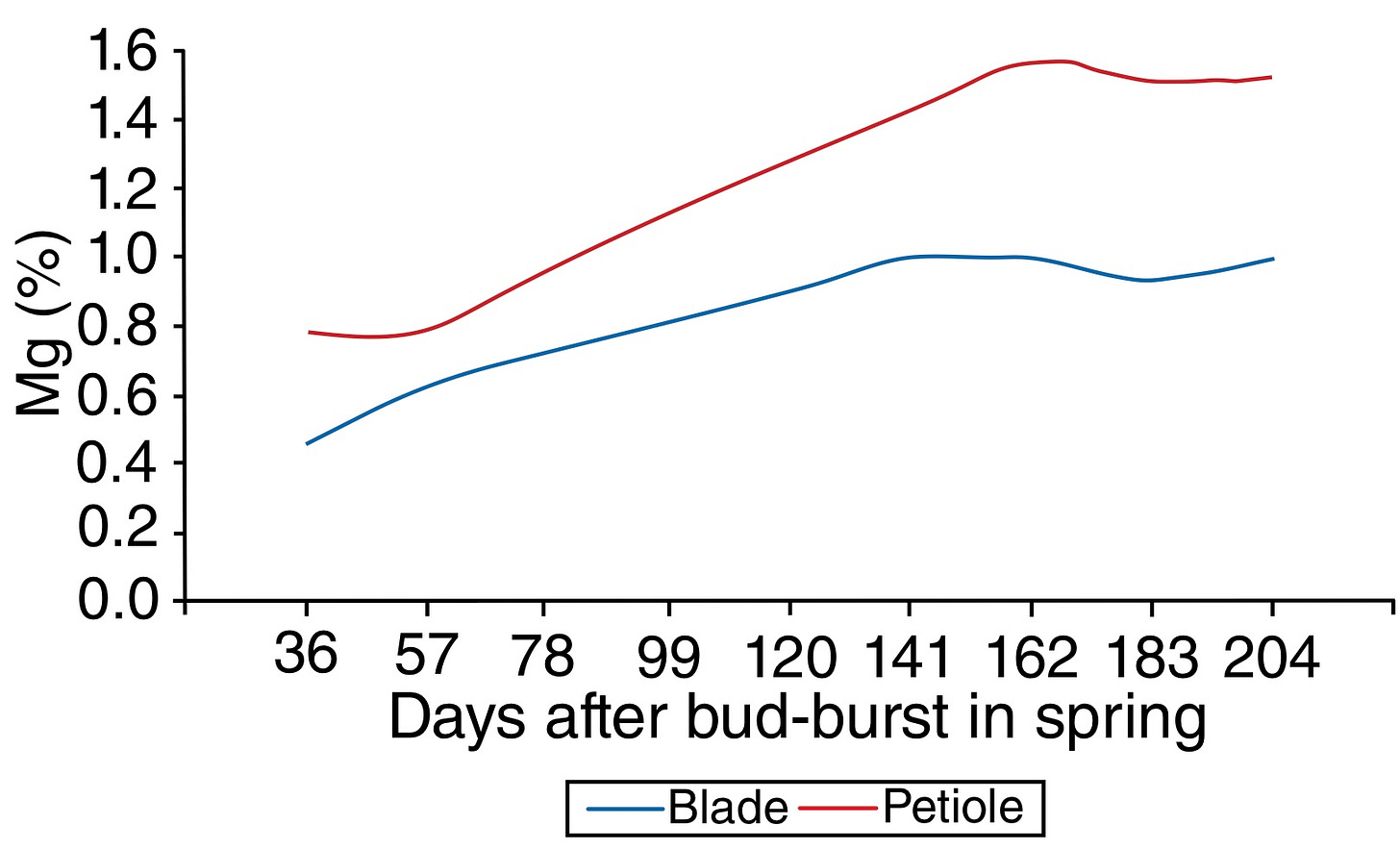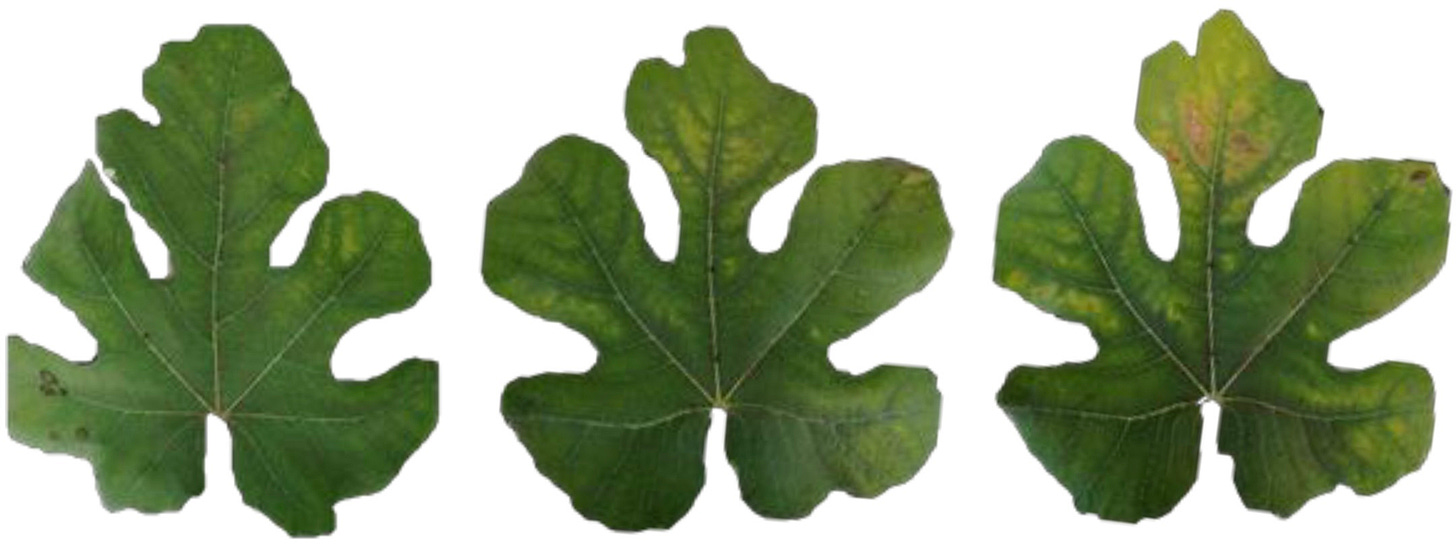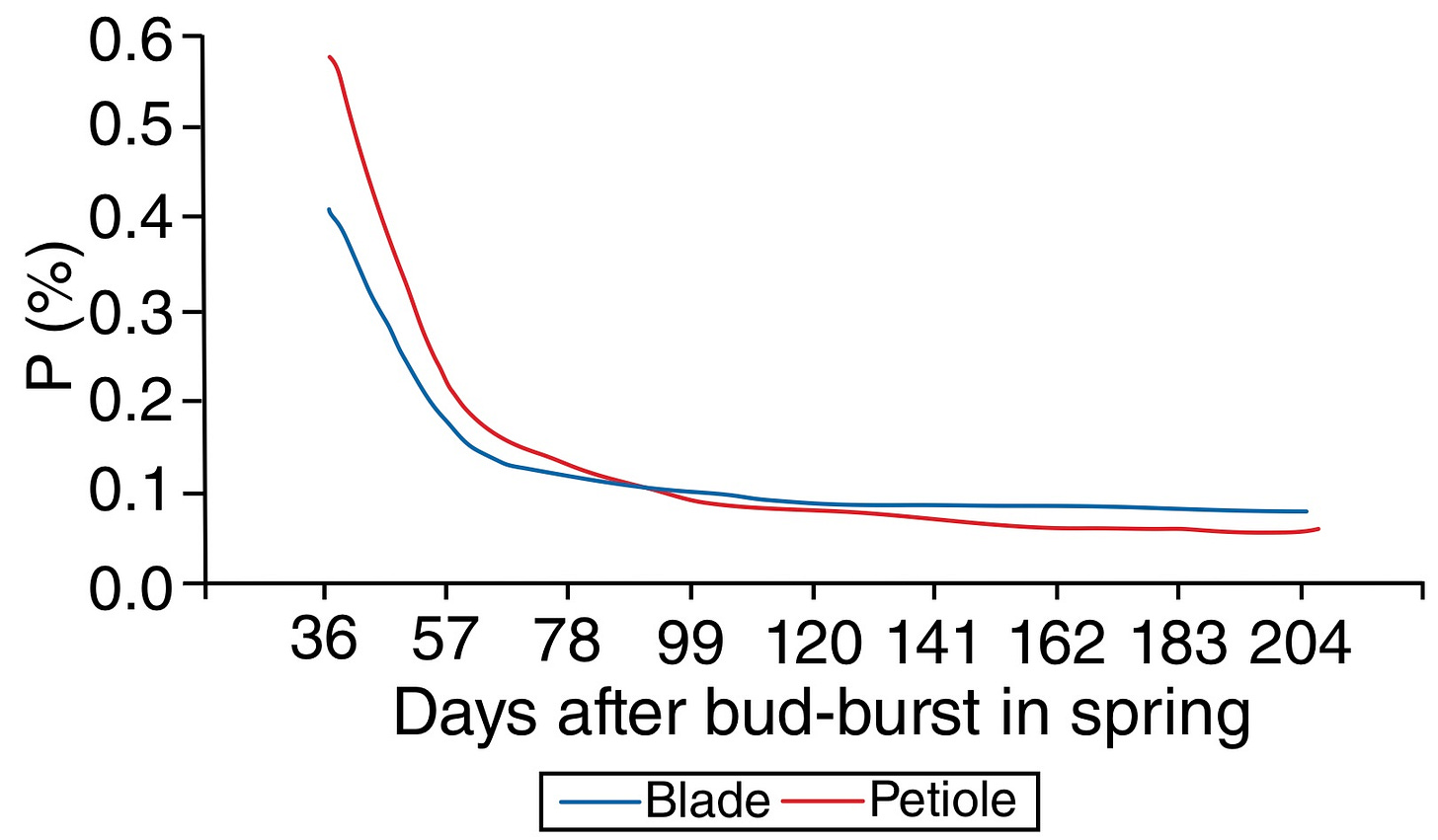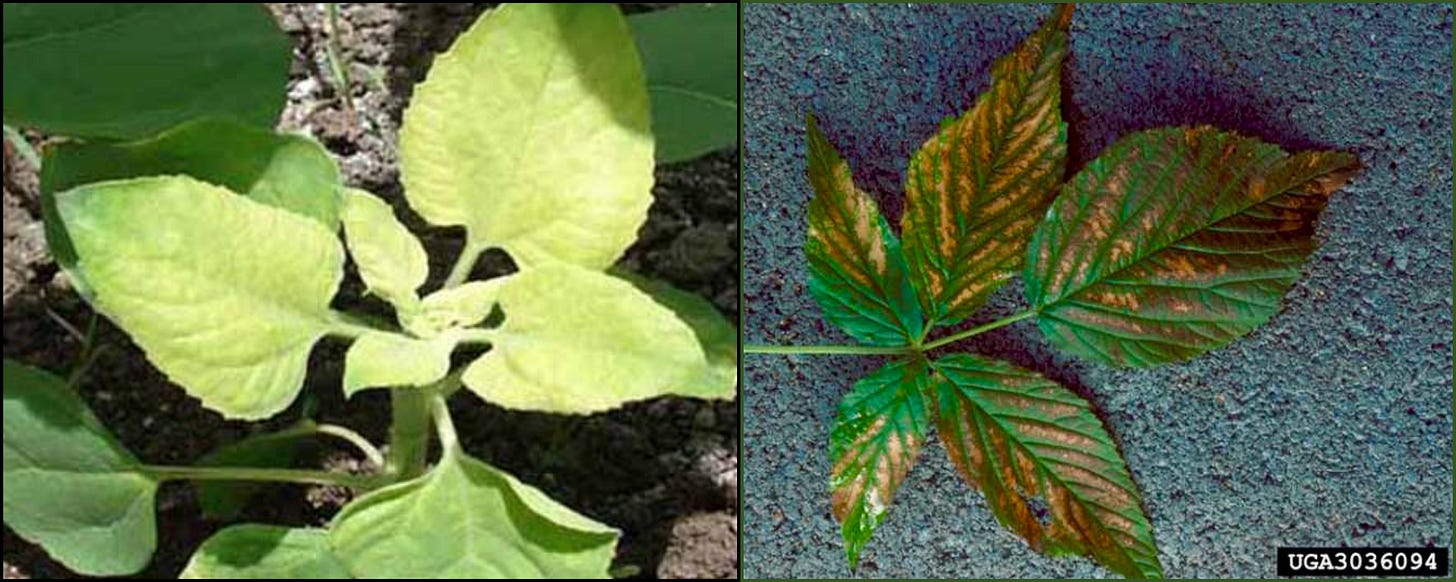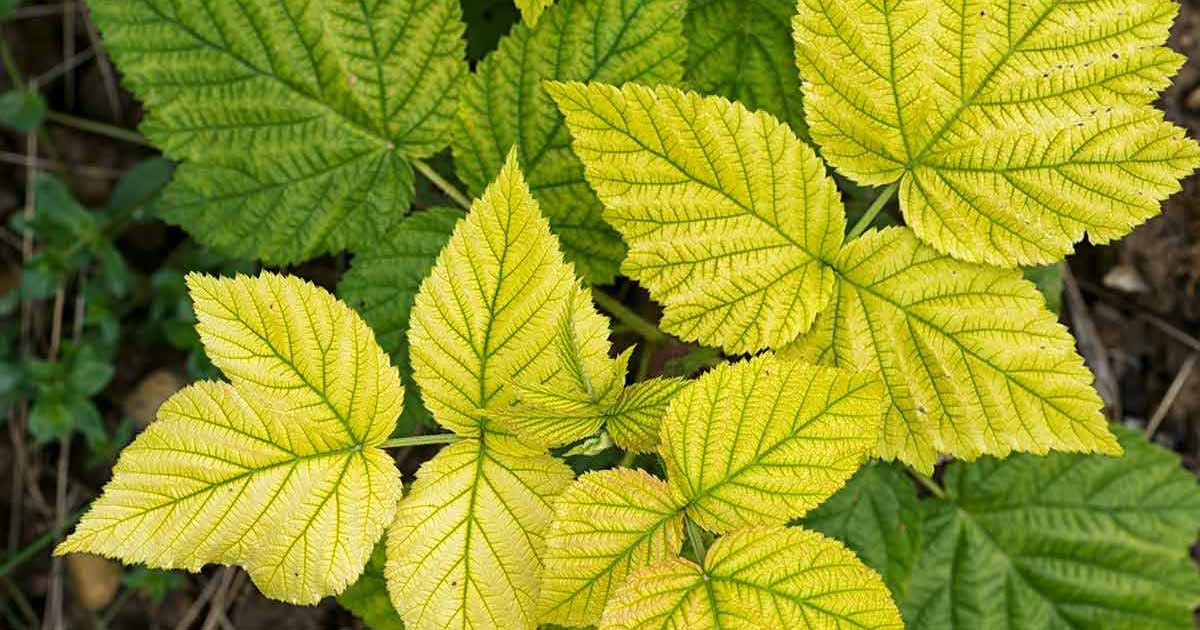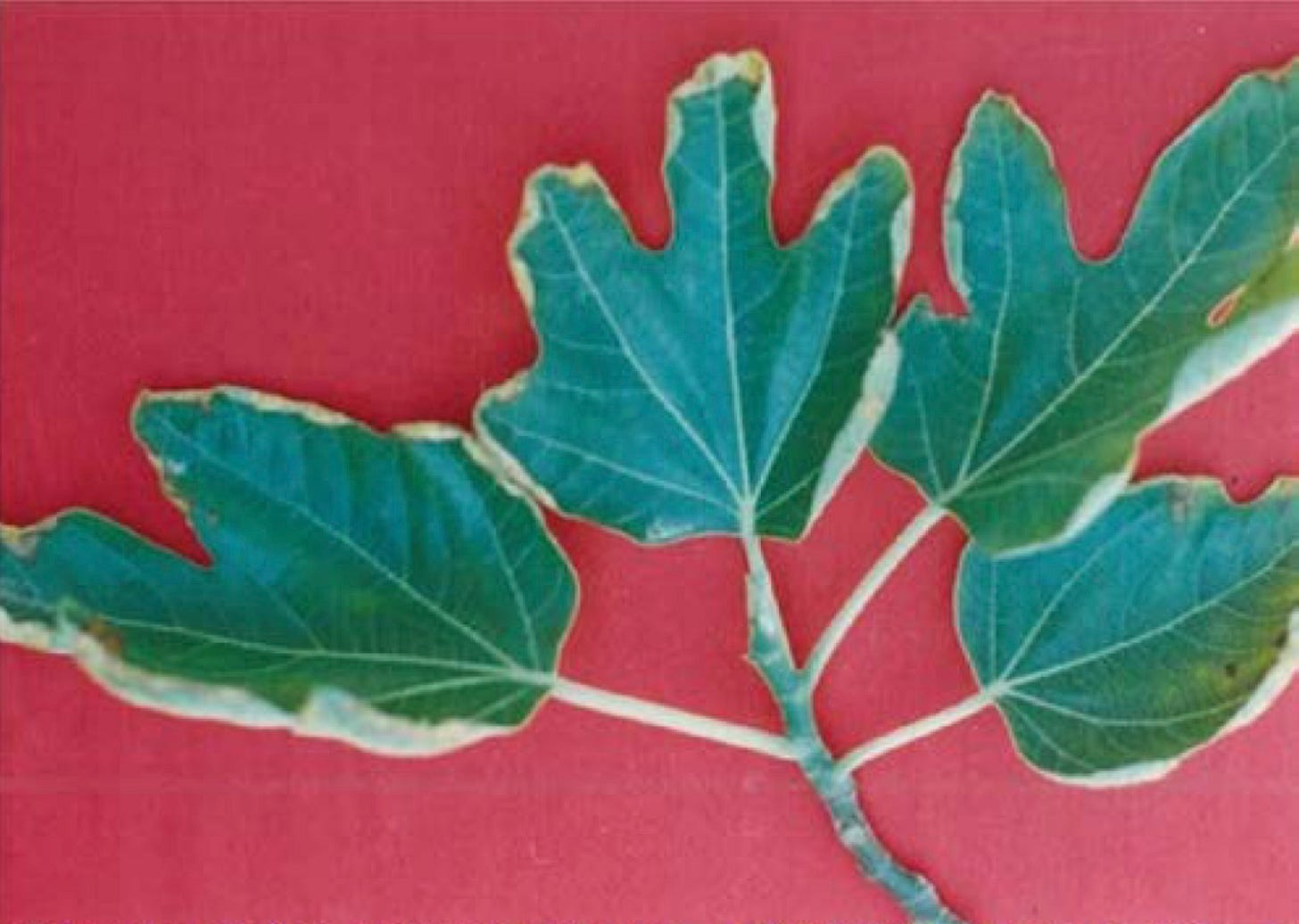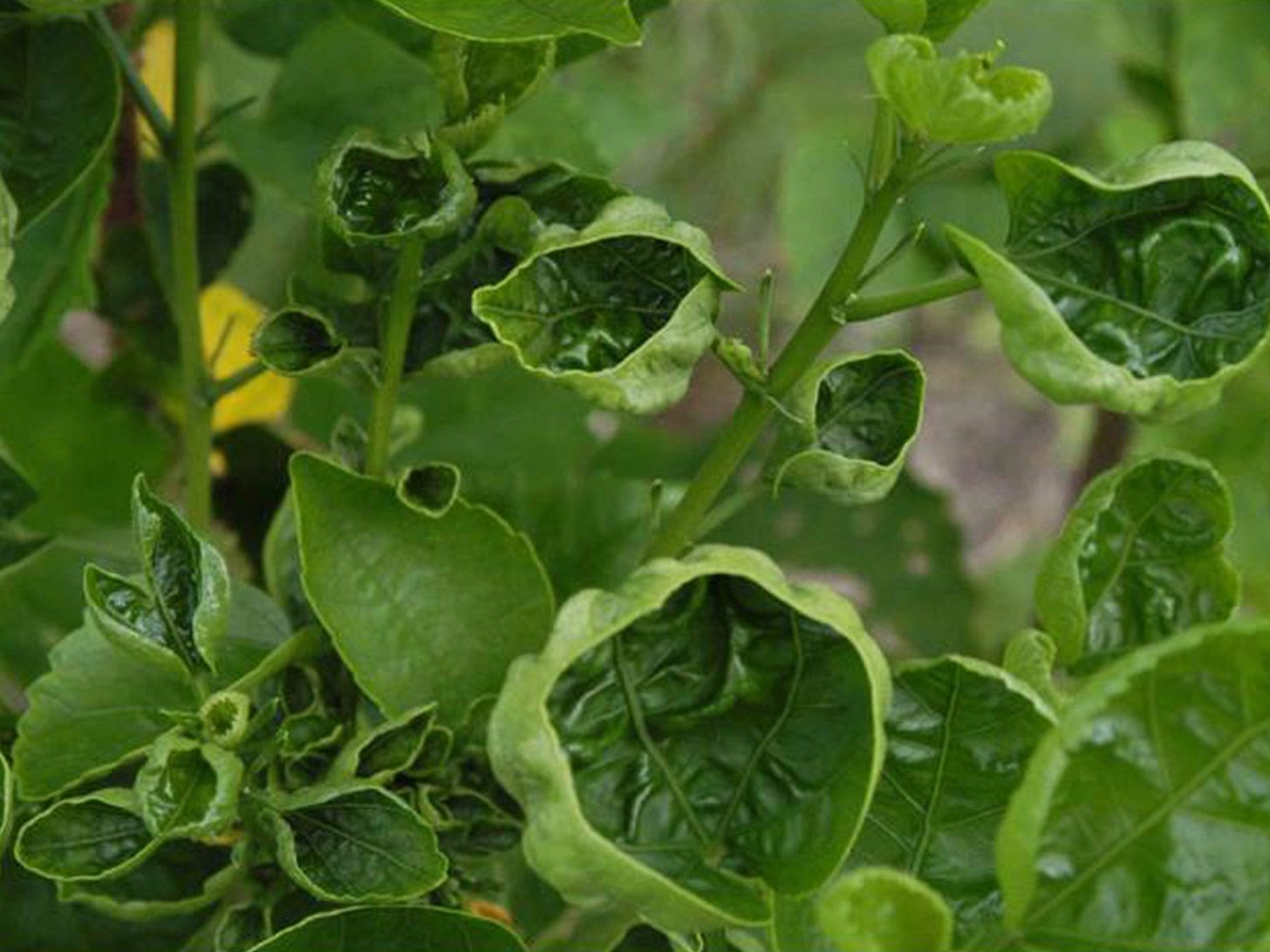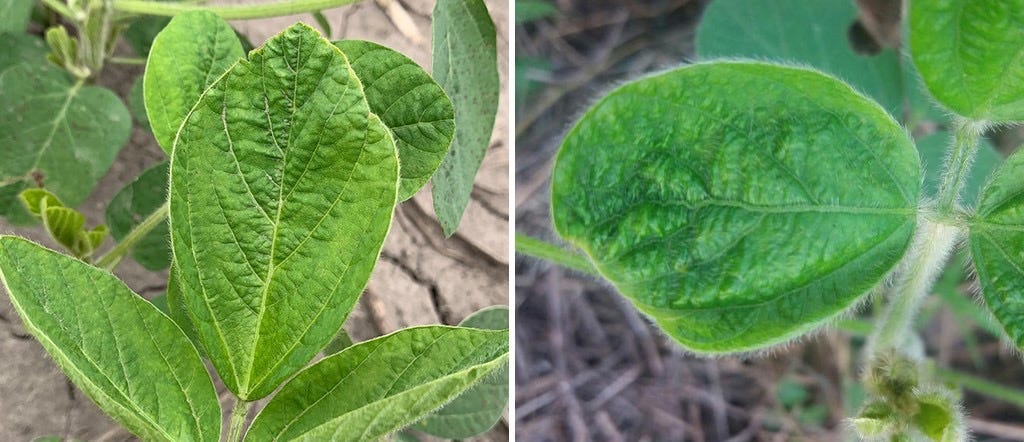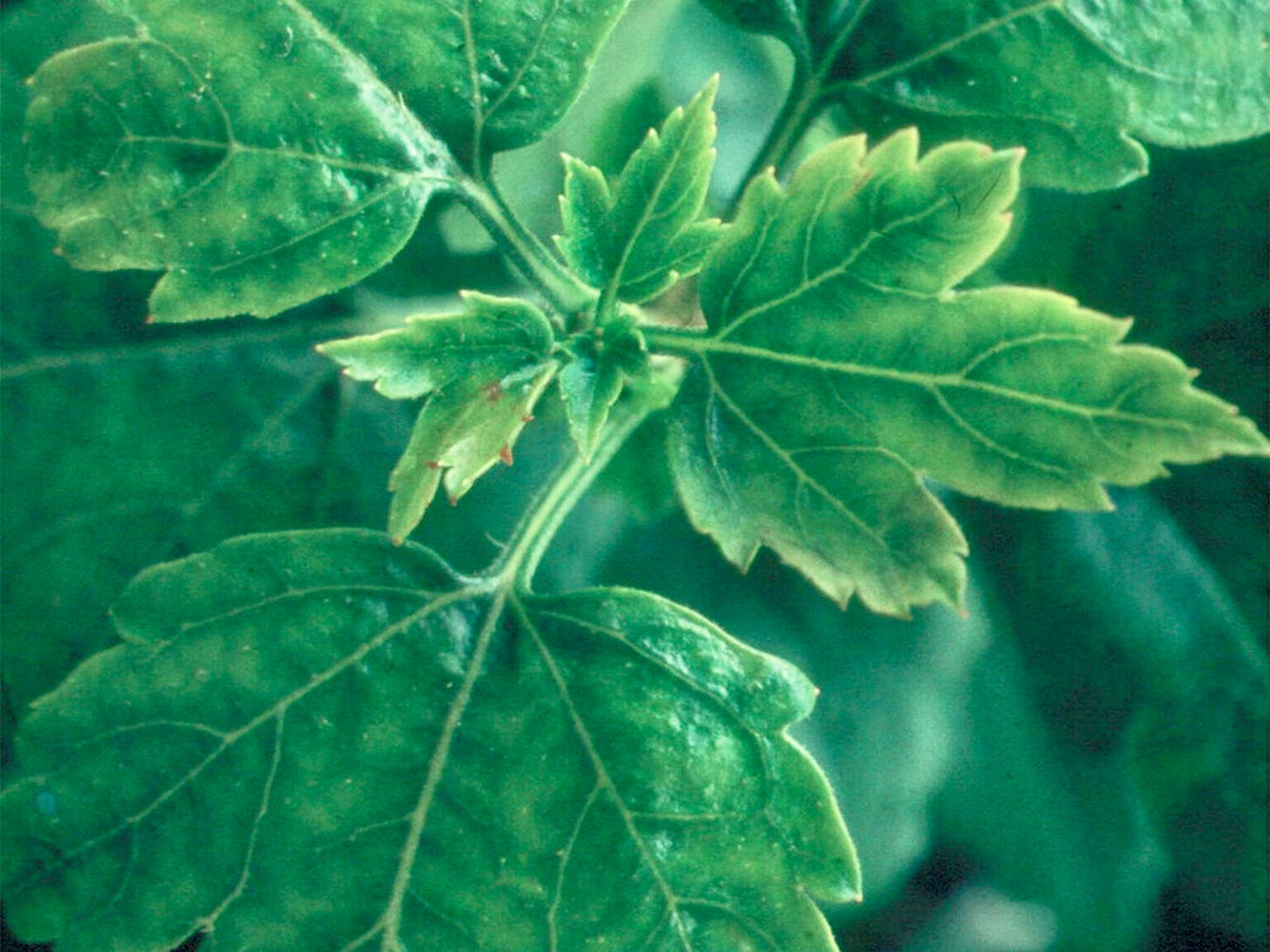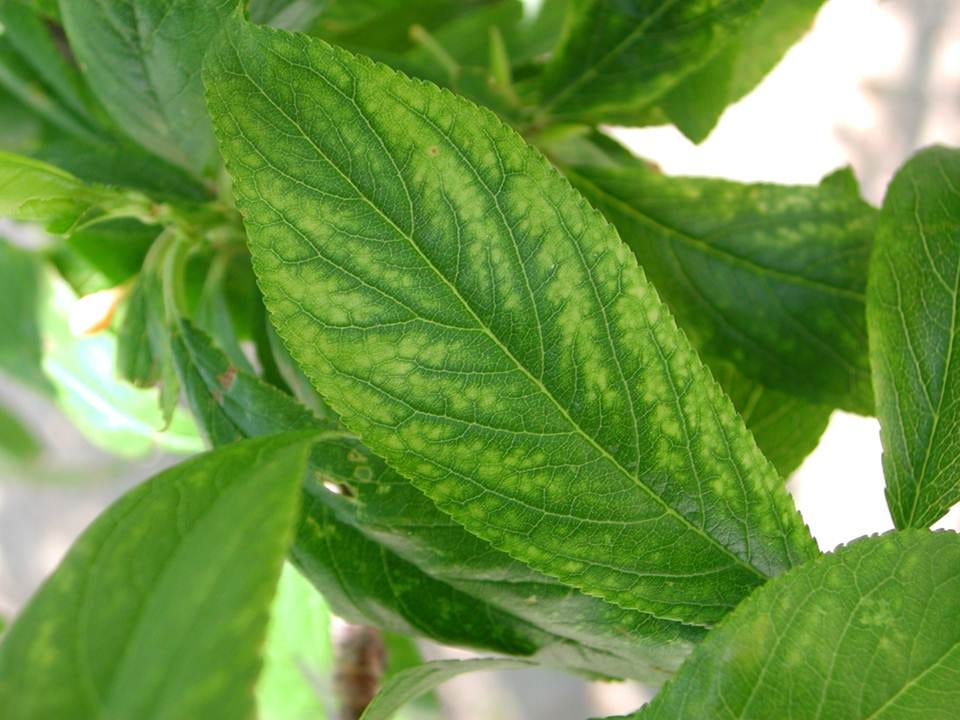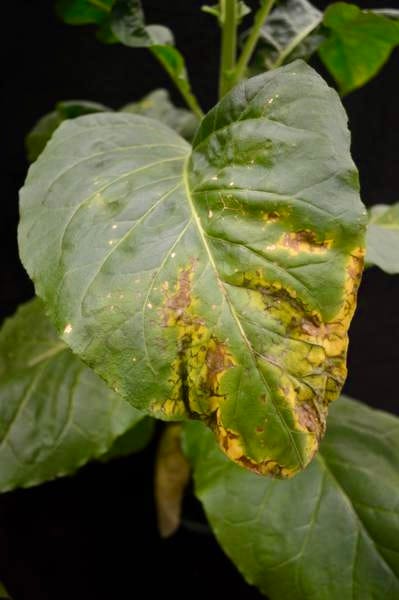What A Fig Tree Wants
Wondering what’s wrong with your tree? Why do the leaves have a funny shape? Does it have a “virus”? Does it need nutrients? What kind of nutrients? This is the post just for fig trees.
I must admit that I haven’t always been the most diligent with nutrients for my collection of fig trees. Figs have relatively low fertilizer needs in comparison to other fruit trees and plants so you can get away with a lot — and I did. I applied things when I remembered to, which could be weekly or once a month, (or not very much at all in some years.) Mostly applications were early in the season when I was excited about things waking up, then life would take over and I would get busy with other things. I didn’t worry much about the types of nutrients and just slapped on whatever seemed good or interesting to me at the time.
Then came the Black Fig Fly (BFF). What words can express feelings over this? I had just collected hundreds of trees and then this pest comes along causing fruit drop and I can’t taste the different varieties I worked so hard to obtain and grow. So then came research for how to effectively deal with BFF. I do like my research after all. I am not going to poison myself over this bug, so only non-toxic things were considered. I created a bait that helped quite a lot for me but which also caught a lot of a lookalike fly. It was also expensive and time-consuming to tend to the traps. I used essential oil sprays with good effect, but again, the cost of regularly applied essential oils can add up. Bagging and netting are always possibilities, but I had so many trees, so again time and cost.
As I began researching more into natural farming, I saw that they had solutions and explanations for why pests happen that in many cases were backed up by research and in all cases were backed up by real-world examples of large-scale growers. Everything linked back to nutrition and plant health. So since we are talking figs here, I needed to research what fig trees need. What I found is that there are generalized ratios for fruit trees and plants… and then there are figs. 🤓 Figs are a little different from other fruit trees.
This is the article that is all about what nutrients fig trees need throughout the growing season, what deficiency looks like, and how Fig Mosaic Virus (FMV) relates to nutrition. The information in this article is taken primarily from various research papers and two publications: 1) Advances In Fig Research and Sustainable Production, and 2) The Fig Botany, Production and Uses. I also used a few other sources as noted at various points in the article.
Index to this article
The disclaimers
We must be frank, research papers have their limitations. They can be a useful tool, but may not reflect real-life situations in your backyard. So the information presented here is just that— information. Some of it is also my opinion on said information. What you do with it is your choice. 🙂
Figs, (specifically Ficus carica in this article,) are tolerant of a wide range of growing conditions. This is one aspect that makes them so enjoyable to grow by people all over the world, they are easy. As such, you can find a variety of recommendations for what fertilizers are best and what feeding schedules to follow. You can be successful with a number of approaches and you really should use the one you feel best about. They adapt well, so someone can have a pretty lousy habit with them and still be a relatively successful grower. But we aren't the lousy ones, right my dear reader? We are going to be the ones on point to the extent within our means which is why we are here.
Historically, fig trees have been considered a crop that did not need fertilization. They are tolerant to poor soils and perform well with low available nitrogen. In fact, negative results were seen with nitrogen fertilization in certain aspects which caused it to not be a primary focus for a time. All this being so, studies on nutrition particular to figs have been lacking and didn’t really take off until after the advent of commercialized fertilizer. Also, most fig production is in the Mediterranean basin and so was not considered a high priority in research originating from other areas. This is why there are some plant-necessary nutrients with very little to no information for figs. There are holes in fig nutrition to say the least.
There have also been two main areas of fig production studied, Turkey and California. They have had very different growing practices and testing criteria for leaf nutrients. California, (including Brazil and the Mediterranean countries in Europe,) is very heavy in irrigation and fertilization and they tested the most recently developed leaves on sun-exposed non-fruiting branches. Turkey relies mostly on rainfall and orchards may or may not be fertilized, (some only fertilize every 2-3 years there.) They tested the third leaf from the shoot base, which is also typically the location of the oldest fruit on the branch. Sampling timing and position of the leaf on the shoot will greatly affect results. So when you see the leaf tissue levels of nutrients below, take them as a suggestive guideline but not as critical levels.
Like any plant, fig trees will grow best in soils with high fertility. The caveat is that they can end up focusing on vegetative growth and not fruit production in such situations. So we are not looking for the highest possible fertility, but adequate fertility for health and fruit quality.
Okay, so here we go!
Nutrients fig trees need
Let’s start with two tables that give us a baseline of nutrient values specific to figs. These are compiled from research papers on the topic. Note which nutrients are higher and lower in amount:
Recommended nutrient levels by researchers:
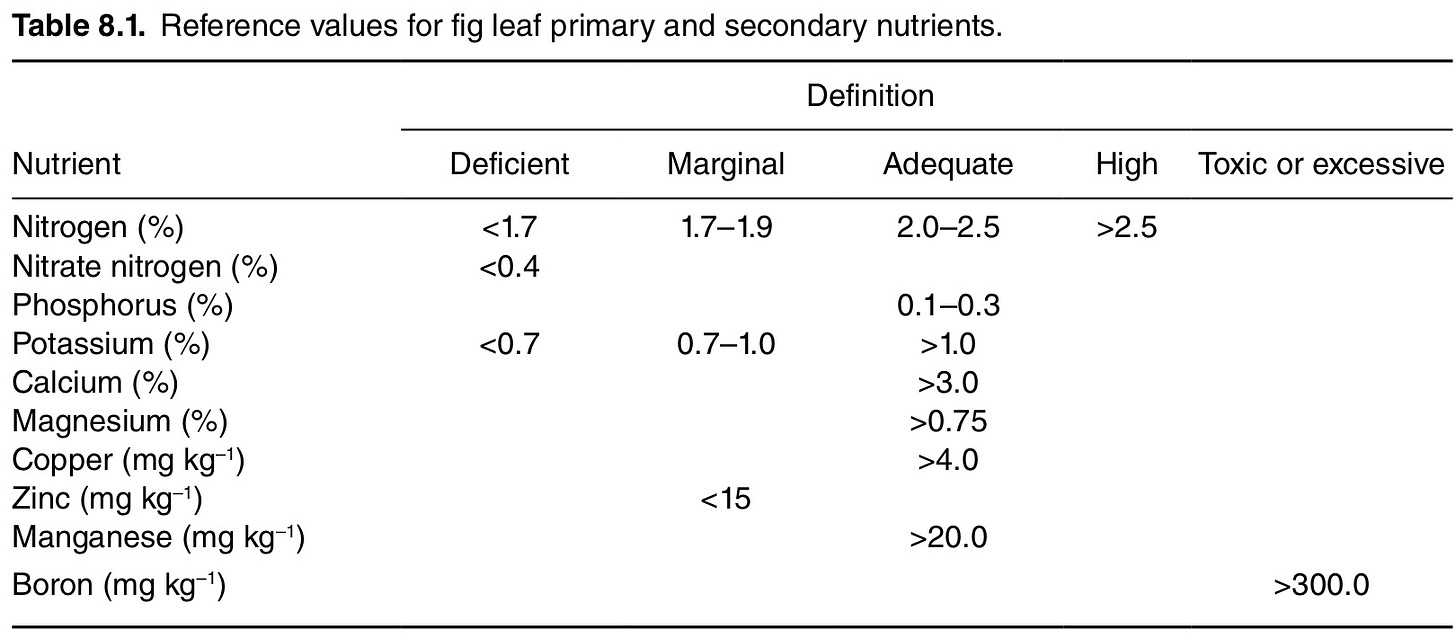
Levels of nutrients from several high vigor orchards:
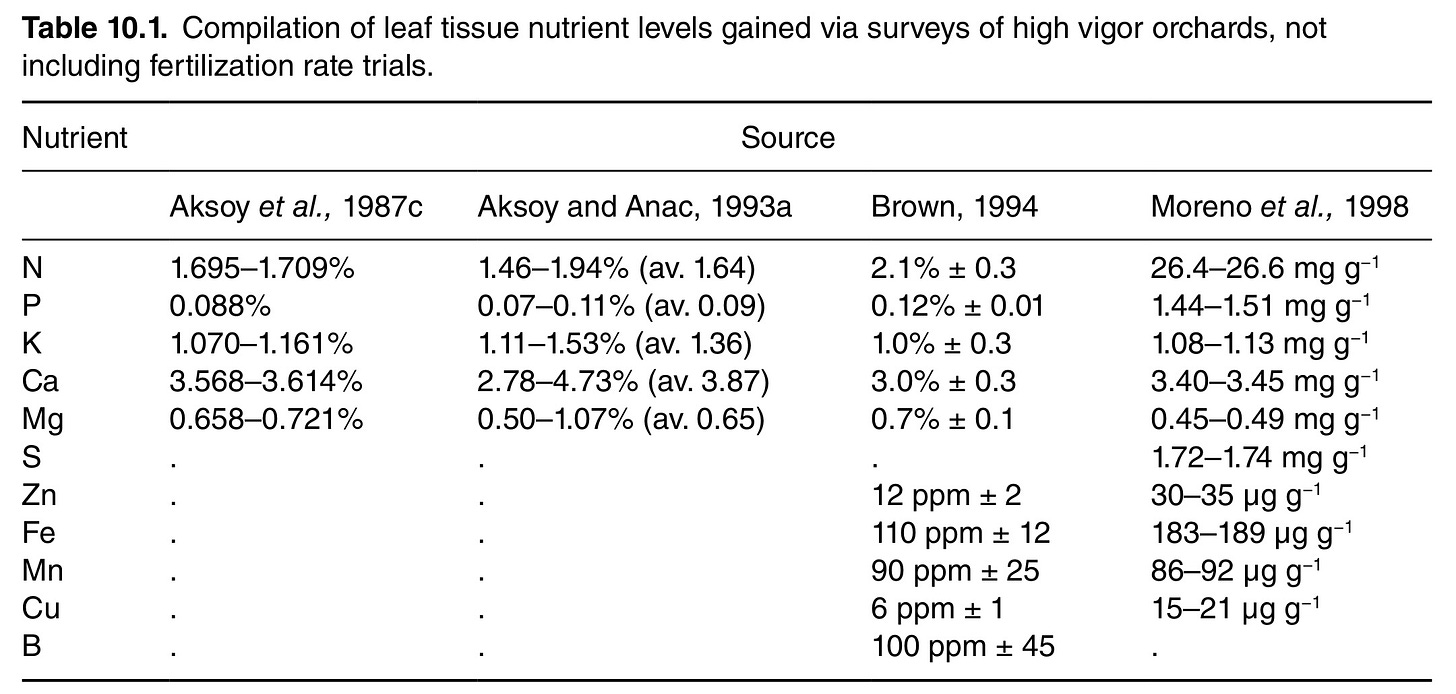
This information gives us an idea of which minerals need to be supplied in higher amounts and it also gives us an idea of proper ratios. For example, you can see that roughly for every 4-5 parts of calcium there is 1 part of magnesium; for every 3-4 parts calcium there is 1 part potassium and so on. Did you notice that the mineral in greatest quantity in most cases is calcium, not nitrogen? Did you also notice phosphorus is very low? We don’t have to analyze this for specific measurements, but it’s to get an idea of it in our minds for what pertains to fig trees.
If you wish to be very exact and technical, you can do a sap analysis to see how your trees are measuring up, that will tell you the exact nutrients they are low/high in based on standard plant levels. This can be beneficial if you are having an ongoing problem, especially since a deficiency of one nutrient can happen along with a toxicity of another which confuses symptoms. This is another reason why I prefer the balanced nutrients in natural inputs— to avoid problems such as that on my end.
The one thing to keep in mind is that each variety and each plant can have its own nutritional issues. It doesn’t matter if all of your trees are in the same soil and on the same fertilizing regimen. Each tree and pot is its own unit and ecosystem. It’s like a family of four, two adults and two kids living in the same house and eating the same food. They are in the same exact environment and getting the same nutrition, but that doesn’t mean one of the kids couldn’t have a nutritional issue separate from the others based on their individual needs and stage of growth. It also doesn’t mean that one can’t end up with a disease independent from the other three. Likewise with our trees, we need to notice and tend to them individually.
Back to index
Deficiencies
For most plants, the best indicator of nutrients is in the leaves. It doesn’t matter if you’ve supplied everything to the soil, what matters is what that plant is actually able to uptake and utilize. Remember that excesses of certain minerals can block out other minerals and that varietal genetics have an effect on nutrient management. It is well documented that various fig varieties respond differently to nutrients. Some are better at taking up nutrients overall than others and some are better at taking up specific types of nutrients than others. We could have one or both things going on. So treat your fig trees as the individuals they are. Also remember that Eh-pH greatly affects soil nutrient availability.
We don’t necessarily need to worry about each of these aspects, we can just let the leaves tell us what is going on. It’s as simple or as complicated as we make it.
Unfortunately, there are not fig leaf pictures for micronutrient deficiencies and we have to rely on other references for those. But there is additional helpful information to determine what type of deficiency we may have.
Because some nutrients are mobile and others are less mobile, the deficiencies have a tendency to show up in certain parts of the plant. You are not going to see a deficiency of one type throughout the entire tree, only in certain parts of the tree, unless it is severe.
At the very top of the plant you are going to see boron and calcium deficiencies. In young leaves going down a little bit from the very top you will see deficiencies in copper, sulfur, iron, manganese, zinc, or molybdenum. In the older leaves at the bottom of a plant you can spot deficiencies in nitrogen, phosphorous, potassium, or magnesium. So if you are seeing indications of a deficiency, note which leaves are being affected where on the plant and take it from there. Location helps to narrow it down.
Immobile Nutrients — These nutrients are not easily transferred within the plant and so symptoms of nutrient deficiency occur first on the upper, youngest leaves:
Boron
Calcium
Manganese
Sulfur
Iron
Copper
Zinc
Molybdenum
Mobile Nutrients — These nutrients can easily be moved from old tissues to young tissues within the plant. So if a new leaf has a need or deficiency, the plant will take from the older leaves to give to the new leaves. Therefore, symptoms of nutrient shortage are noticeable first on the lowest, oldest leaves:
Magnesium
Nitrogen
Potassium
Phosphorus
Nutrient deficiencies that can cause distorted growth or deformities:
Calcium (new or young leaves)
Boron (new or young leaves)
Copper (young leaves first)
Zinc (young or middle leaves first)
Molybdenum (young leaves)
Nutrient issues that can cause necrosis (scorching) on edges or tips:
Calcium (new or young leaves)
Boron (new or young leaves)
Copper (young leaves first)
Potassium (lower/ older leaves)
Toxicity
Nutrient deficiencies that cause whole leaf chlorosis (yellowing):
Nitrogen (old leaves)
Sulphur (young leaves, light veins)
Iron (young leaves, green veins)
Nutrient deficiencies that cause interveinal or blotched chlorosis (spotted or striped yellowing) (can turn into necrosis spots in the leaf):
Manganese (newer or young leaves)
Zinc (young or middle leaves)
Molybdenum (young leaves)
Magnesium (lower/older leaves)
Here is a deficiency chart from the internet that may help to give you a visual of the above:
Do you have a case of “ugly leaf”? One of the most common deficiencies you will see in fig trees is calcium. It is the nutrient with the largest requirement but is often undersupplied by home growers. If you have a case of leaf deformity with mottled chlorosis, it’s likely to be calcium coupled with deficiencies in micronutrients, like boron and/or manganese. This plant is hungry. These deficiencies are often the first to show up in spring growth and in rooting cuttings. Remember they are shown in newer leaves which is why you are seeing them in these settings. Also, this type of new growth mainly relies on stored nutrients that need to be available in the fall before dormancy. So if this step was overlooked, it’s likely deficiencies will show in that first growth.
Conversely, because fig trees are often grown in high calcium and magnesium soils, and therefore have higher soil pH, you can end up with deficiencies in potassium, boron, iron, manganese, zinc, and copper which require a lower pH to be plant available.
Leaves are the first step, but there is one problem notable about fig trees…
They notoriously have hidden hunger symptoms which are not always visible in leaves. They are reflected in reduced shoot growth and in reduced fruit quality or yields. Other visual cues to note are cracking, sunscald, and abnormal sizes in fruit.
We joke about pictures of split figs looking like the plant in Little Shop of Horrors or something from Alien, wanting to feed on something. But apparently, it literally does need food and is a sign of hunger. So if you have “Feed me, Seymour” figs, they’re talking to you, and they need some food!
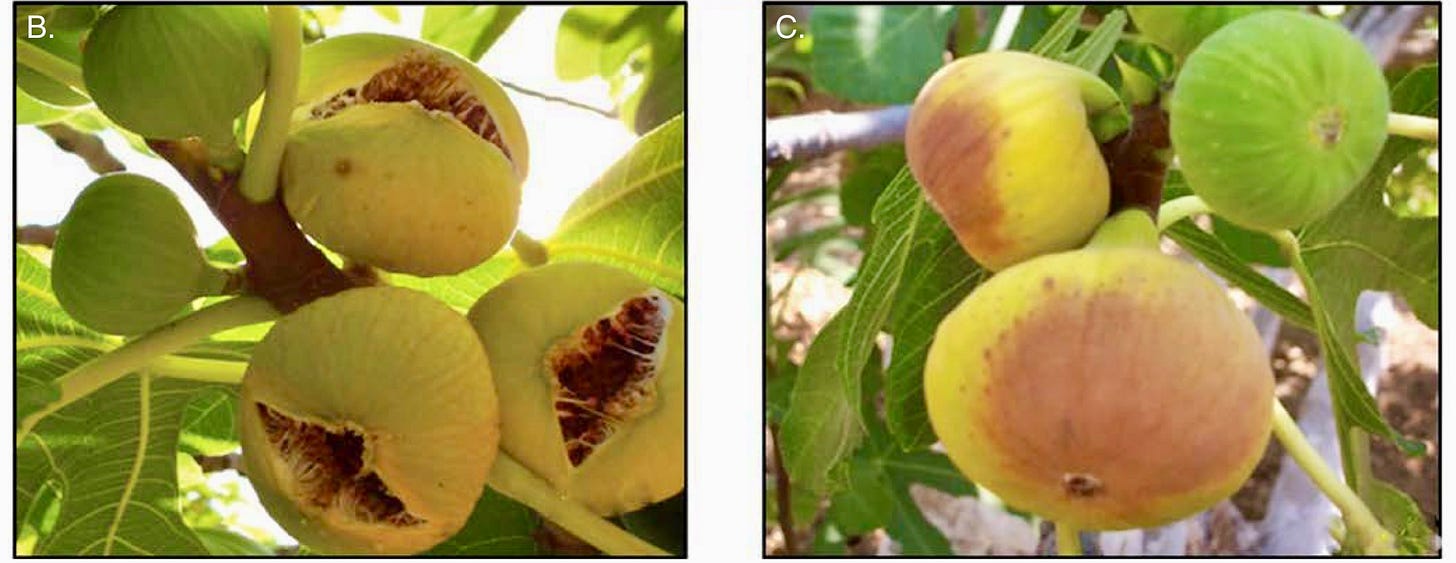
Nutrients that affect shoot length and internode spacing:
Calcium
Nitrogen
Magnesium
Zinc
Copper
Boron
Nutrients that affect splitting and sunscald (both in fruits and shoots):
Calcium (Prevents splitting, excess linked to sunscald)
Potassium (Prevents sunscald, excess linked to splitting)
Nitrogen (excess linked to splitting)
Boron (excess linked to splitting)
What is the fastest way to correct an active deficiency? This is through foliar spraying. As noted in the foliar spray article, the primary way plants take in nutrients is through the roots and this is ideal. However, if you have a deficiency and don’t know why, like maybe you applied a lot of calcium but yet show signs of deficiency, it could be that another nutrient is blocking it or that the soil environment is off. Another possibility is that the plant itself has problems taking up that nutrient. Going directly to the foliage will get it where it needs to be in a faster way and bypasses any soil issues. Just keep in mind that with the nutrients that aren’t very mobile, they are going to stay pretty much in the area you applied them. The phloem flow won’t move them to other parts of the plant. So make sure to spray all sides and parts of the tree when foliar spraying for deficiencies.
If you have a really strong deficiency, you may wish to go directly to a specific mineral product to provide a heftier initial correction before moving to a milder plant-based input. I still recommend looking at a balanced product versus an isolate when possible. Two products new to me that I think might be useful for this are BioAg Cal-Mino and BioAg CytoPlus or TM-7.
The other thing to keep in mind is that much of the growth we see in spring is from stored nutrients from the previous season. The initial cellular growth and formation is happening on a microscopic level that we just can’t see or know about. So key nutrients may have been missing when your fig tree started silently yawning awake and future growth may not reflect corrections of certain minerals for a while. Just be patient and supply what is needed moving forward.
Excesses and Toxicities
Most nutrient excesses show as a deficiency for a different nutrient because the excess has blocked the other nutrient(s). The exception to this is salt burn from excessive use of chemical fertilizers and the leaf curling/twisting you can see in ammonium excess. If you are using chemical or mineral fertilizer, you are more likely to end up with excesses than if you use fertilizers from plant sources. Some animal based fertilizers also can cause excesses, such as with manure or bone meal. Certain varieties of fig trees may also on their own take up excesses of certain nutrients causing a blockage of another.
Back to index
Macronutrients
Listed in order of need and abundance in fig tree tissues:
〉Calcium (Ca)
In fig trees, calcium is the most abundant element in all tissues and could be considered the most important nutrient for them. Calcium significantly affects the vegetative growth and quality of fig fruits, such as shoot length, fruit dimensions, cracking, total soluble solids, acidity, fruit size, and color. Fig tissues (leaf, fruits, and wood) contain more calcium than other deciduous fruit trees. Leaf calcium concentration increases throughout the vegetation period, meaning that the tree is continuously uptaking and utilizing it.
Because the majority of growers are habituated to think of NPK as the important nutrients, calcium is often dropped or not supplied adequately to fig trees. You can frequently see signs of calcium deficiency in many pictures online, even in stock images. Because calcium deficiency causes chlorosis and deformed leaves in new growth, many growers incorrectly attribute these symptoms to FMV.
The leaf deformation seen in deficiency is due to calcium’s role in cell walls. It “is necessary for cell wall stability and extension, and cellular membrane stability. It is also a second messenger in some signaling pathways. Due to its role in cell wall stability, it is critically important in fruit development and storage life,” according to the fig books.
Cell walls of all plants have pectin in them which is made with calcium — calcium pectate. It is the glue that holds all plant cells together. It is what gives structural strength to all living things. It is essential in new cell growth and development, and it can boost plant immunity, growth, and repair. Without calcium, plants are weak, prone to disease, and attract pests.
What many may not know is that calcium can be used to drive growth in plants much like nitrogen. The difference between the two is that calcium will get you tighter internode spacing, quality wood, and gives both vegetative and reproductive growth. Nitrogen pushed growth gives you thinner wood with long, stretched internode spacing. Tighter internode spacing, (think 2 inches instead of 4,) is more desirable as it increases crop yield. So calcium gives the higher quality vegetative growth.
Research has shown that calcium nutrition significantly affects fig fruit cracking, meaning that it prevents it. It also has a bearing on cracking seen in tree trunks. The negative is that a high amount of calcium can increase sunscald and lower sugars in fig fruits. This is where we need balance with potassium. Potassium prevents the sunscald associated with high calcium and calcium prevents the fruit splitting associated with high potassium. Potassium also increases sugars which counters the lowering associated with high calcium. Balance. It’s all about the balance and proper ratios.
As noted elsewhere, different varieties can have different sensitivities with specific nutrients. Calcium and potassium are two nutrients that can have variances in uptake and reaction amongst different fig varieties. This is where it is really important to treat each tree individually if you see signs of deficiency because what is deficient in one could be excess in another if you have already been supplying appropriate nutrients to your trees. And then the deficiency in the one, if unattended to, could affect growth, fruit development, and quality in that tree.
Phosphorous and zinc can bind with calcium in soils tying it up and preventing uptake. Excess phosphorus can show as calcium deficiency, so it's important to know what we’ve applied to understand what is going on. For example, many Bloom Boost products are excessively high in phosphorus which could then cause calcium deficiency in your trees. Aluminum, heavy metals, and sodium can also interfere with uptake.
Calcium availability increases in hydrated soils so this is something to consider if we have a tendency to go dry often.
Deficiency and toxicity:
Deficiency shows as chlorosis and deformation of younger leaves at the very top of the tree or branch tip. Calcium is not phloem mobile, therefore calcium deficiencies can occur in young leaves or fruits as these tissues are partially supplied via phloem flow. The entire leaf may be light green or speckled (likely from concurrent sulfur or micro deficiencies,) and shoots and stems can be weak. New leaves may emerge with a grey or white coloration that is rolled and necrotic.
There is nothing said about calcium toxicity for figs, no doubt because figs do love it. But it is important to know that too much calcium can cause iron, magnesium, and potassium deficiency generally speaking for all plants.
How to handle calcium:
This is the graph of calcium content and usage as measured in fig leaves throughout the season:
You can see it has a rising need as the season continues. It is typical to see this pattern in plants with nutrients that are less mobile as leaf transipiration drives their flow; meaning the more leaves, the more it is pulled up through the xylem. Because calcium is often applied to soils in granular or powder form, it is important to apply it both in the fall and in the spring. These forms of calcium take time to become plant-available. If you miss the fall application, it will not be available at those critical moments in spring of cell formation for all tissues including fruit. This can especially affect any breba and first leaves.
The fig books recommend both soil and foliar feeding of calcium. Water-soluble calcium is quickly available. Any foliar feeding should cover the entire tree on all sides as calcium is not mobile in phloem and will mostly stay where absorbed. Foliar feeding is considered more of a bandaid for calcium since it will not move from where it is applied. It is best for it to come from the soil and roots when possible since it moves through the xylem flow.
Sources of calcium:
Dissolve pieces of shells, eggshells, bones, or calcium carbonate sand in food grade vinegar for water-soluble calcium. This can be diluted and foliar sprayed or soil drenched. More directions are in this article.
Mycorrhizal fungi and compost tea help to increase calcium uptake. Healthy plants can also be composted or used in JADAM liquid fertilizer (JLF) or KNF fermented plant juice (FPJ) for a quick, soluble calcium source. LABS, whole milk (preferably raw), or whey can also be a supplemental source of calcium.
Bone meal, oyster shell flour, gypsum, garden lime, and wollastonite are all granular or powder forms that can be applied to the soil multiple times in a season.
Here is an interesting one: Amino acids open calcium uptake channels in plant roots, reportedly increasing uptake by 1,000 times. EM-1, compost teas, and fish amino acids (FAA) all provide amino acids to plants and should be utilized to boost calcium applications. There is also a bulk product available by Diamond K called 7/11. It is calcium with amino acid based nitrogen. It has an NPK content of 7-0-0 and 11% calcium. It is very similar to BioAg Cal-Mino or GreenGro Green Aminos which may be more accessible and are in smaller packages. This too can be a quick fix for deficiency or used to push growth in the vegetative period.
Gypsum is the most commonly recommended calcium product because it does not raise pH and also supplies sulfur. Gypsum starts becoming available after about 30 days from application depending on climate and moisture levels. It’s availability dramatically rises after around 45 days and continues to be available for up to 90 days when it then declines. So gypsum takes 1.5 months from application to really be available and needs to be reapplied by the 90-day decline in order to ensure a continuous supply. This will matter more for potting mixes since nutrients are washed out of pots.
Lime is another source of calcium and figs are noted as loving lime. However, there are some cautions to its use. There are two types of lime generally used for gardening in powdered or pelleted form: garden lime and dolomite lime. Garden lime is ground limestone and is primarily calcium carbonate. Dolomite lime is very similar, but is made from dolomitic limestone, and is about 50% calcium carbonate and 40% magnesium carbonate. (The high amount of magnesium is not recommended unless deficient.) These both fairly quickly raise soil pH by quite a bit which then affects the availability of all other nutrients. They also take a long time to become plant-available, upwards of 6 months. You are more likely to wash this out of your pots before it ever becomes a usable source of calcium to your trees when growing in pots. So it is only recommended for in-ground trees as a calcium source and only as a pH adjuster for potted trees. An acid is recommended to make it more readily available for potted trees.
〉Potassium (K)
In generalized plant terms, potassium is the element most needed by plants after nitrogen. But here again is where we need to get specific to figs. Fig potassium levels are slightly higher than nitrogen and fig fruits are one of the highest in potassium. In the study by Brown (1994), potassium levels were noticibly different between high-vigor and low-vigor orchards, with high-vigor orchards having higher levels. Potassium nutrition does not have a lot of effect on vegetative growth, but it is noted as affecting osmotic pressure in stomata which affects cell/water balance. Deficiencies in potassium will then affect photosynthetic rates and cell expansion. A deficiency will also affect sugar transportation in the phloem.
Potassium has a lot of effect on fruit growth and quality. It has an effect on fruit size, lighter colors, softness, sugars, and moisture content. Higher potassium amounts are also associated with a larger ostiole size as fruit size increases. Potassium can reduce acidity in fruit and increases total soluble solids and sugars which can mean higher Brix.
Potassium is very effective at reducing fruit sunscald, (you will want to note this especially if you live in a hot, sunny climate.) However, high amounts of potassium can exacerbate fruit cracking, especially in soils with low available calcium. It is recommended to consider soil properties and calcium/magnesium ratios when fertilizing with potassium. Balance is absolutely your friend here for the best fruit quality along with timing. Calcium is important in the cellular formation stage, in that very first stage of fruit development. Potassium comes in after in balance with calcium.
Because fig fruit does have a high demand for potassium, you will see lower numbers of it in the leaves compared to the fruit. (See the charts below.)
In one study, they noted a fairly constant balance in fig trees between K/Ca levels through stage 2 of fruit development, but then potassium went up in relation to calcium in some varieties susceptible to cracking around stage 3. The variety did that on its own.
It’s important to point out that potassium is antagonistic to calcium and magnesium. One study found that fertilizing with potassium decreased both leaf and fruit calcium and fruit magnesium levels while increasing nitrogen levels in fig fruit. This could be one reason why both nitrogen and potassium are associated with fruit cracking. The hint here is to remember manganese which is the gatekeeper to potassium.
Some soils (or potting mixes) that contain illite (a type of clay) or vermiculite can fix potassium, meaning they make it unavailable in the short term. It is released in the long term though. So, if you have an immediate potassium need, they can hold it back from plants and if you have an overage, they will store it and continue to release it.
Deficiency and toxicity
Potassium deficiency shows as chlorosis at the edges that expands toward the center of the leaf, followed by necrosis at leaf edges. Potassium is mobile so plants will steal it from older leaves to give it to new growing leaves. This is why deficiencies of potassium show up in older leaves and not newer ones.
There isn’t a whole lot said about toxicity with potassium, just that it will block other nutrients in excess. It is important to remember manganese with potassium— it helps both with deficiencies and excesses. Manganese is basically the key to potassium, it knows when to lock the door and when to unlock the door for its use in plant tissues.
How to handle potassium:
This is the graph of potassium in fig leaves throughout the the season:
You can see in the leaf blade, it is not immediately needed in the spring but is fairly even about a month after dormancy breaks through the rest of the season. In the petiole, it comes in high and then tapers as potassium is transferred from the leaves into developing fruits and remains at a very slow decline the rest of the season.
Because potassium is so water soluble and easily absorbed by roots, slow and steady is best. Balance with other minerals is also extremely important. Personally, I would not choose an isolate with this one.
Sources of potassium:
Wood ash, compost, worm castings in particular, compost teas, FPJ, JLF, blackstrap molasses, langbeinite, greensand, kelp meal and seaweed extract are a few sources. What I love about seaweed extract and molasses is that they also contain manganese. GreenGro Nature’s Brix is another.
〉Nitrogen (N)
Nitrogen is considered a critical nutrient for amino acids in plants and it is one of the most important nutrients affecting vegetative growth. It affects shoot length, number of leaves, and yield (fruits per shoot).
Figs have lower nitrogen needs compared to other orchard crops. It is also generally desirable to have lower nitrogen rates because excess nitrogen reduces fruit quality, delays in maturity, and is associated with an increase of aflatoxin contamination.
Anything that increases the number of nodes produced per season should increase the amount of yield which is how nitrogen helps in this case. Nitrogen also helps with photosynthesis which in turn helps with sugar production.
There are different requirements for nitrogen between common and Smyrna figs. Common figs require more nitrogen than Smyrna types, and it is considered undesirable to push for excessive growth with nitrogen in Smyrna varieties. The desired amount of shoot growth in Smyrna varieties was stated to be 15-20 cm, or 6-8 inches, with 4-6 fruits per shoot. Nitrogen fertilization is only recommended when shoot growth is less than 15 cm or 6 inches. In some cases, increased nitrogen led to smaller fruits with poor color.
Common varieties have three times more nitrate than Smyrna varieties in stages 1 and 2 of fruit development. This is associated with regulation of indole-3-acetic acid oxidase, a type of auxin hormone related to vegetative growth.
High nitrogen leads to a decrease in the amount of dry matter in fresh fruit and an increase in water content. Although fresh fruit size is increased by higher water content, fruit cracking may increase in some varieties due to higher internal pressure exceeding the skin resistance. Excessive nitrogen enhanced vegetative growth at the expense of fruit yield in the Brown Turkey variety and resulted in larger but hollow fruits with elongated peduncles (stems) in the Bursa Black variety. Excesses also may result in watery or insipid flavors in fruit.
Deficiency and toxicity:
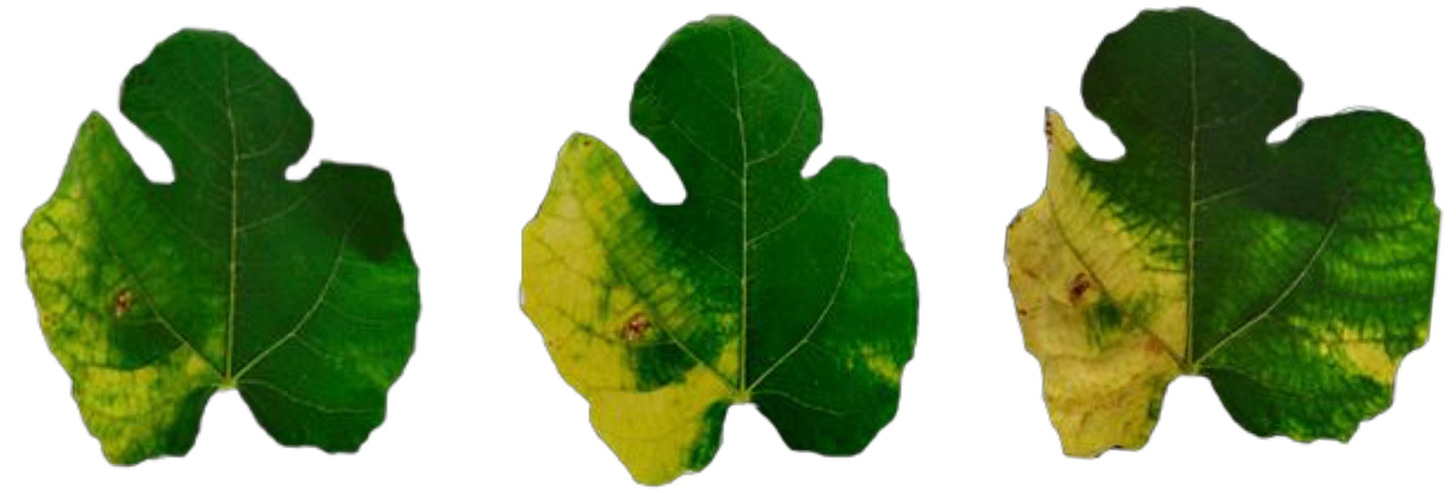
Signs of deficiency are pictured above. Even though nitrogen is considered necessary to plants, too much of a good thing can be bad. Nitrogen at levels plants cannot fully synthesize will attract pests and pathogens. Too much can also negatively affect taste of produce. Nitrogen toxicity looks like extra dark green leaves, delayed or absent fruiting, deformity of the leaves, lack of nodulation, or even burning from nitrates on plant surfaces.
How to handle nitrogen:
The uptake pattern and seasonal variation in figs should be taken into consideration. Because it can negatively affect fruit quality, it may be best to let applications taper off once fruit set has happened. Prolonged nitrogen fertilization can also prevent lignification of shoots, which is important if you live in a colder climate or have earlier first frost dates.
Nitrogen concentration in fig trees, in terms of leaf, fruit, and shoots, is highest prior to the spring growth flush and decreases during the vegetation period. A rapid decrease in nitrogen concentration takes place during two different periods: in the spring period of rapid leaf growth, and just before leaf drop in the fall. The one is because of rapid leaf growth in the spring and the other is due to nutrients moving from the leaves into 1-year-old shoots.
The current season and 1-year-old shoots are the main nitrogen source to support the initial vegetative development period of the next season. The nitrogen requirement for the spring growth flush is derived largely from this nitrogen reserve. The nitrogen reserve plays an important role in determining shoot length, and the number and size of fruits per shoot in the following season. If you do a lot of pruning each year completely removing these shoots, you will lose this nitrogen store.
The typical compost or manure applications in spring and fall for in-ground trees is ideal timing for when fig trees are utilizing and storing nutrients. We can match that for potted trees by supplying compost, worm castings, or amino acids throughout spring growth and then for a very short period right before leaf fall.
Here is a chart showing nitrogen usage and content by fig trees throughout the season:
Sources of nitrogen (or the preferred amino acids):
Compost, worm castings, fish hydrolysate, fish amino acids (FAA), manures such as rabbit, goat, or chicken (aged), JADAM liquid fertilizer (JLF), KNF fermented plant juice (FPJ), urine (aged and/or fermented), compost teas, alfalfa meal, and green manure are all quality sources of nitrogen.
Inorganic or synthetic nitrogen is not recommended by me personally because it is inefficient, polluting, and harmful to health. Only 40-50% of chemical nitrogen is used by plants and the rest is wasted. In The Fig Botany, Production and Use, they also expressed caution in using chemical nitrogen because of its inefficiency and polluting nature and only recommended use when needed. In one study, fig trees fertilized with inorganic nitrogen ended up deficient in nitrogen as opposed to another study where trees fertilized with manure maintained levels. As such, I recommend natural sources which seem to be better utilized and support soil structure and life. This is especially so since fig trees are not a nitrogen-heavy plant in comparison to others.
Excesses of all forms of nitrogen, inorganic or organic, can increase pest pressure. One reason for this is that plants use nitrogen to form amino acids, when there is too much nitrogen, there is an excess of free amino acids. Insects love free amino acids because they are very nutritious to them. You need a balance with other minerals, such as potassium, for these amino acids to be converted into less digestible and more complex forms of proteins, starches, and cellulose to keep insects away.
〉Magnesium (Mg)
Magnesium is a critical component in cellular metabolism. It is the central atom in chlorophyll, is important for some protein structures, and is required for many enzymatic reactions. Magnesium assists with photosynthesis and making leaves green. Shoot length is affected by magnesium levels.
Like calcium, magnesium leaf tissue levels steadily increase through the growing season. The concentration in fig fruit is variety dependent.
Magnesium has an antagonistic relationship with calcium and potassium. All three of these affect each other, so it is important that these are in balance and none in excess. Too much potassium can show as magnesium deficiency in general in all plants.
Deficiency and toxicity:
Magnesium deficiency shows up in bottom, older leaves. The leaves yellow from the bottom of the tree up as the plant moves magnesium to the new growth and in the leaf, the chlorosis moves outwardly from the leaf veins.
Deficiencies are typically only seen in acidic, heavily weathered soils, but deficiency can happen if there are excesses of other nutrients in the soil such as after heavy applications of calcium or potassium. Magnesium deficiency is actually fairly rare and not really documented in figs as they tend to be grown in higher pH soils. Also, magnesium is found readily in most soils.
There are no toxicities associated with magnesium since plant roots regulate its uptake from the soil.
How to handle magnesium:
This is the graph of magnesium usage in fig trees throughout the season:
If you are supplementing calcium and/or potassium with potted trees, it is good practice to supplement with some magnesium as well. Calcium should always exceed magnesium by quite a bit, usually a ratio of 7:1, calcium: magnesium, is recommended for all plants. This may not be necessary for in-ground trees unless you see signs of deficiency. (It should be noted that magnesium can have a negative effect on soils, it makes soils tight, anaerobic, and hydrophobic. In soil, you want significantly more calcium than magnesium.)
Sources of magnesium:
Epsom salts, dolomite lime, most plant JLFs or FPJs, FAA, vinegar extractions of oyster shells, cow bones, eggshells, or shrimp shells, most fermented plant extracts, compost, compost teas, animal manures, langbeinite, and greensand.
〉Phosphorus (P)
Fig trees have a lower requirement for phosphorus compared to other fruit trees. You can see this reflected in the numbers above where multiple other minerals are quite a bit higher. While phosphorus is an important nutrient, excess of it is negatively associated with fruit quality.
There isn’t a whole lot more said about phosphorus for fig trees other than the importance of mycorrhizal connections for it. It is well known that mycorrhizae makes phosphorus available to plants. The catch is that soils high in soluble phosphorus inhibit fungal growth. This means we want to give it through organic matter which does not have that effect. Certain organic matter is known to be a stable source of phosphorus while encouraging fungal relationships, so it is the desirable form to use.
For most plants, phosphorus is essential for reproductive aspects. It helps with root development and early flower formation. In generalized plant terms, it is said a single foliar application of phosphorus and manganese can switch a plant stuck in vegetative mode over to reproduction.
Each plant type has different needs for phosphorus and so application is based on that. Figs have a lower requirement, so it isn’t one we need to pump a lot of into the system. No Bloom Boost is needed here which is often excessively high in soluble phosphorus and can block the very necessary calcium.
Deficiency and toxicity:
Phosphorus deficiency in figs is observed with a deep green coloration in the leaves, followed by patchy chlorosis which begins in the center lobe, and then evolves into necrotic spots as shown below. For many plants, deficiency can slow growth and show purple or red coloration on leaf edges and stems. So plants can look stunted and purplish red which may or may not show in fig trees.
With phosphorus toxicity, plants develop chlorosis, the leaf tips appear burned, roots die back, and other essential nutrients (Ca, Mg, Zn, Fe) become deficient which can confuse a visual inspection of what is affecting the plant.
How to handle phosphorus:
This is the graph that shows phosphorus amounts and usage by fig trees over the season:
You can see that it really tapers down in tissues over the season and is mostly utilized at the start until it stabilizes to a very low amount.
Because phosphorus is best supplied through arbuscular mycorrhizal relationships, encouraging fungal growth is important. You can inoculate your potting mixes with certain species. You can also dip the roots into a mycorrhizal solution before planting in-ground or in pots. In one very controlled lab study on fig trees, G. caledonium, G. margarita, G. intraradices and G. clarium mycorrhizae species were considered more effective than others used in the same study. The least effective was a cocktail mix of all species used in the study.
Leaf mold soil from local old-growth forests of deciduous trees can also be a very effective inoculation for mycorrhizae. It is especially beneficial because these microorganisms are compatible with your environment and climate, whereas controlled isolated species are compatible with lab environments and may or may not last in your area. Small amounts of leaf mold soil can be used in composts, compost teas, JLF, JADAM microbial solution, worm bins, fish amino acids (FAA), in wood chip mulch, as well as other applications.
Wood based mulch is also helpful for encouraging mycorrhizal growth in the soil underneath. Just be careful not to have mulch up against the trunk of your trees.
Phosphate solubilizing bacteria (PSB), such as Pseudomonas and Bacillus, also makes phosphorus readily available.
Phosphorus is easily soluble and therefore easily leached from soils. Having a steady, slow-release supply in organic matter is therefore more desirable compared to liquid applications. The good news is that the types of organic matter that supply other important nutrients also supply sufficient amounts of phosphorus, so it is not something we have to isolate out to provide for fig trees. Fig trees have a very low need for phosphorus and it is not needed in great abundance. Reiterating no Bloom Boost, it does more harm than good.
Sources of phosphorus:
Manures (especially bird), worm castings, urine, bone meal, vinegar extraction of bones, bat guano, JLF and FPJ also often contain certain amounts of it, FAA and vinegar extractions of the fish remnants also contain a good amount of it.
〉Sulfur or Sulphur (S)
… Okay, and that’s a wrap!
No, but seriously, there is nothing really said about sulfur in the fig books. It seems that sulfur deficiencies in figs have never been investigated. Only Moreno (1998) suggested critical values for leaf sulfur of 0.17%, which is consistent with other plant values. This is not to say it is not necessary for figs, just that there doesn't appear to be any research specifically on it.
So this is some generalized information on sulfur from Matt Powers' book Regenerative Soil:
“Sulfur is required by plants for their cell structure, amino acids, photosynthesis, and respiration… Sulfur contributes to flower formation, lipid production, and plant aroma, and it, along with zinc, triggers flowering… a sulfur deficiency is a protein deficiency… Sulfur is a critical component of the plant immune system… Once a pathogen attack is detected, the plant develops a Sulfur-Induced Resistance (SIR) response… it is in shorter supply in soils that are lacking in organic matter and proper soil biology… If your plants are facing fungal pathogens, raising sulfur levels in the soil and in the plants themselves may be exactly what’s needed by providing what’s missing.“
Deficiency and toxicity:
Sulfur deficiency looks a lot like nitrogen deficiency except that it shows as yellowing in young leaves higher up on the plant, the location is different. (Nitrogen deficiency shows in older leaves at the bottom.) Veins are also often pale green in sulfur deficiency. (If you have green veins, think iron instead.) Toxicity is relatively rare but can happen when overly applied. In toxicity, plant leaves will appear burned like from salted winds.
Sources of sulfur:
Sulfur is found in most proteins and in sulfates. It is present in FAA, JLF, FPJ, vinegar extractions, epsom salts, gypsum, organic matter, and langbeinite.
Back to index
Micronutrients or Trace Elements
Listed in order of need and abundance in fig tree tissues according to the few that have been studied:
Note that there is very little information for figs specifically as regards micronutrients. You can see that molybdenum, silicon, selenium, and others are missing from the above list. They just have not been studied for figs according to the books, it does not mean they are not needed. In one analysis of a fig FPJ, all micros were present and silicon showed as the highest micronutrient. (It should be noted that isolated applications of silica can negatively affect fruit taste and so should only be applied earlier in the season if used and not close to ripening.)
Micronutrients are critical in the function of plant disease protection. According to Chuck Shembre, “Micronutrients play a crucial role in enhancing plant immunity and protecting against diseases. They are often the missing link in plant nutrition and are not well understood in most fertility programs. If the soil biology is poor, then most micronutrients are low in the plant.“
It should be noted that the uptake of many micronutrients is greatly affected by and enhanced with mycorrhizal fungi. In one study about mycorrhizae and figs, it had a bearing on zinc, iron, copper, and manganese availability, (also phosphorus, but we’re talking micros here.) The other micros were not analyzed in this study. Getting biology going in your soils is essential for nutrient uptake.
〉Iron (Fe)
Iron is involved in redox reactions and protein synthesis and is directly involved in photosynthesis. Even though iron deficiency is often shown in plants growing in high pH soils, it is rarely documented for figs, which may be because of fig trees’ tolerance to soils with higher pH and carbonates.
Iron levels in fig leaves either remain steady throughout the season or decline. Iron levels are not associated with vigor.
Excess manganese can lead to iron deficiency generally speaking for all plants since the two minerals work together in balance.
Deficiency and toxicity
Deficiency shows on young leaves as interveinal chlorosis while veins remain green. So it looks very similar to sulfur deficiency, but the difference is the green veins.
Typically toxicity occurs in acidic soils below 5.5 pH and under ideal conditions, plants with sufficient iron levels turn off uptake to keep iron levels within proper ranges.
Sources of iron:
Iron is already widely available in most soils, it just is not always readily accessible. Biological life and chelators help to make it accessible. It is also present in blood meal, bone meal, FAA, and all FPJs. Greensand is another source.
〉Boron (B)
Boron is immobile in fig trees as Ficus carica does not transport photosynthates as sorbitol. (Sorbitol facilitates boron phloem transportation generally speaking in plants.) Boron plays a role in cell wall pectins, cell metabolism, membrane integrity, flower production and pollen tube growth. It is extremely synergistic with calcium and helps move calcium into the very tips of plants. You can often see calcium and boron deficiencies together for this reason. Sometimes calcium deficiency isn’t lack of calcium but lack of boron to help push it to the outer edges of leaves.
Figs are one of the most sensitive crops to boron toxicity, but they are also a boron accumulator, meaning they like boron. Excess boron is negatively associated with fig fruit cracking especially if calcium is low. From other resources, it is stated that boron toxicity really only happens if there is not enough calcium in the soil. This makes sense as they do work together and harmonize in purpose in a plant.
Boron adsorbs to clays. So its availability for uptake is higher in sandy soils, and deficiencies are also most often seen in sandy soils due to the lack of clay to hold it.
Deficiency and toxicity:
Toxicity is more documented with figs than deficiency, meaning that deficiency doesn’t seem to have been studied. Toxicity has been so because some soils in fig orchards contained excessive amounts of boron leading to symptoms of toxicity. Excess levels of boron will accumulate in the leaves. In toxicity, you will see leaf edge scorch, defoliation, dieback, a decrease in fruit set, cracking, and hollow fruits in figs. Boron toxicity in many plants can resemble calcium deficiency and it is said that it is difficult to have toxicity if there is sufficiently available calcium.
Boron deficiency can have a telltale cupped shape in leaves:
It should be mentioned that fig leaves in general will cup upwards to regulate leaf transpiration. Please do not confuse that with boron deficiency. Also frost damage can cause some leaf edge distortion. In boron deficiency, it’s almost like there’s an invisible string along the leaf edge that has been pulled taut, cupping edges unnaturally. Leaf tips often have a burnt edge look as well.
Even though boron deficiency has not been studied in figs, it seems to be the second most common deficiency seen in newer leaves and newly rooted cuttings. It, like calcium, is a major cause of ugly leaf and symptoms of deficiency are often confused with FMV by growers. Both calcium and boron deficiency are very similar to each other and affect the same leaves. This is no doubt because, like calcium, boron affects pectin in cells. So when symptoms are present, calcium is only assumed to be the primary deficiency because that mineral is needed in greater quantity. However, many fig leaves reflect boron deficiency as well. So in a case of ugly leaf, calcium, boron, and manganese should be supplemented depending on what has already been applied. Boron deficiency also can cause slowed or stunted growth.
Boron deficiency is in the top most, newer leaves like calcium and leaves can be distorted like with calcium. In deficiency, leaves are often wrinkled and puckered (bumpy). Leaves can be thickened or brittle as well. Sometimes you will see new leaves emerging looking dry or having crunchy edges. A reddish cast may be noticed initially on new leaves. Chlorosis can also be seen at leaf edges.
↑ The pictures immediately above and below show boron deficiency in other plants and are very similar to how fig leaves look to me with boron deficiency. ↓
Boron deficiency leaves plants open to disease, pests, and pathogens because of the breakdown in cell wall integrity. High rainfall areas often have deficiencies because boron is easily leached away. If toxicity happens, there should always be a source for the toxicity that you can trace back to, such as applied isolated minerals, ant baits with boric acid, contaminated soils, composts, or irrigation water.
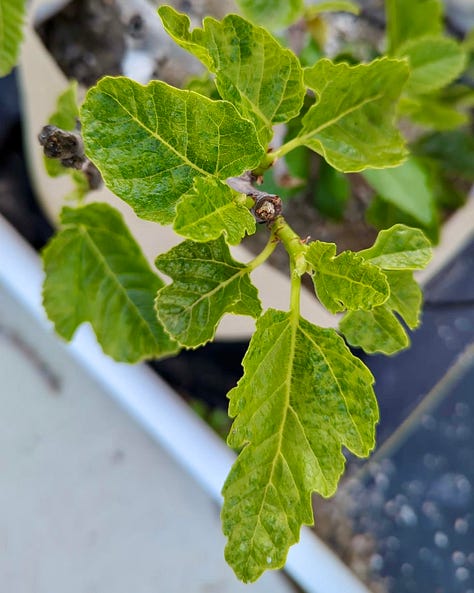
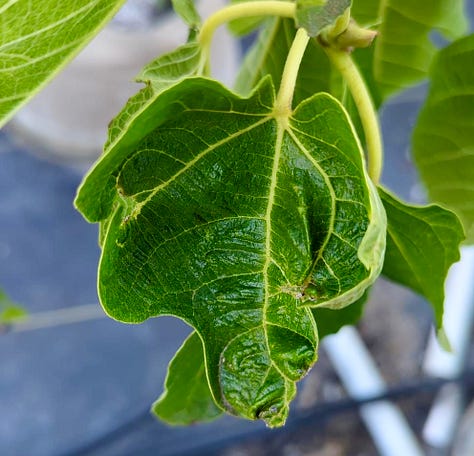
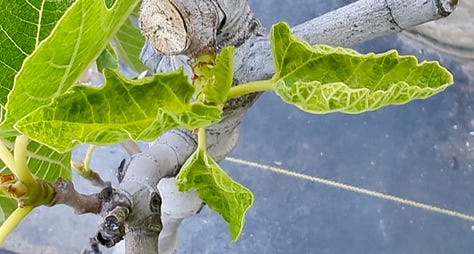
Sources of boron:
Kelp is rich in boron. Soil organic matter is essential for regulating boron. Both deficiency and toxicity, especially in sandy soils, can be treated with compost, biochar, and kelp. All vinegar extractions and FPJs contain boron. BioAg Boro-Mino and borax are other sources as isolates.
〉Manganese (Mn)
“Manganese is a cofactor for many enzymes, and a component of superoxide dismutase, an essential enzyme that detoxifies free radical oxygen. It is also involved with cellular metabolism and involved in root extension. Manganese can be toxic to plants at low soil pH due to its increased availability. Its availability is reduced under high soil pH conditions with large concentrations of carbonates,” according to the fig books. The latter may be why many figs can shows signs of deficiency in young leaves and rooting cuttings.
Leaf manganese has been positively correlated with fruit fructose, glucose and total sugar in figs. This especially makes sense because of its high involvement with photosynthesis and its regulation of potassium.
Leaf manganese levels in figs spike at the beginning of the season and are also higher at the end of the season, while tapering off in the middle. Figs may be sensitive to manganese toxicity in low pH soils where manganese can become excessively available. Excess manganese can lower vigor in such cases.
Deficiency and toxicity:
Manganese deficiency shows as leaf chlorosis in young leaves higher up on the tree or branch. Leaves can have a checkered or mottled appearance from chlorosis with light and dark patches and frequently seem to grow away from the problem. Key word is “seem”, it often moves to hidden hunger in figs if not addressed. There are no specific manganese deficiency photos for figs. However, manganese deficiency often goes along with calcium deficiency and boron deficiency. So photos of both often reflect manganese deficiency as well. The photo below, which I have shared in other places, is likely a deficiency of all three:
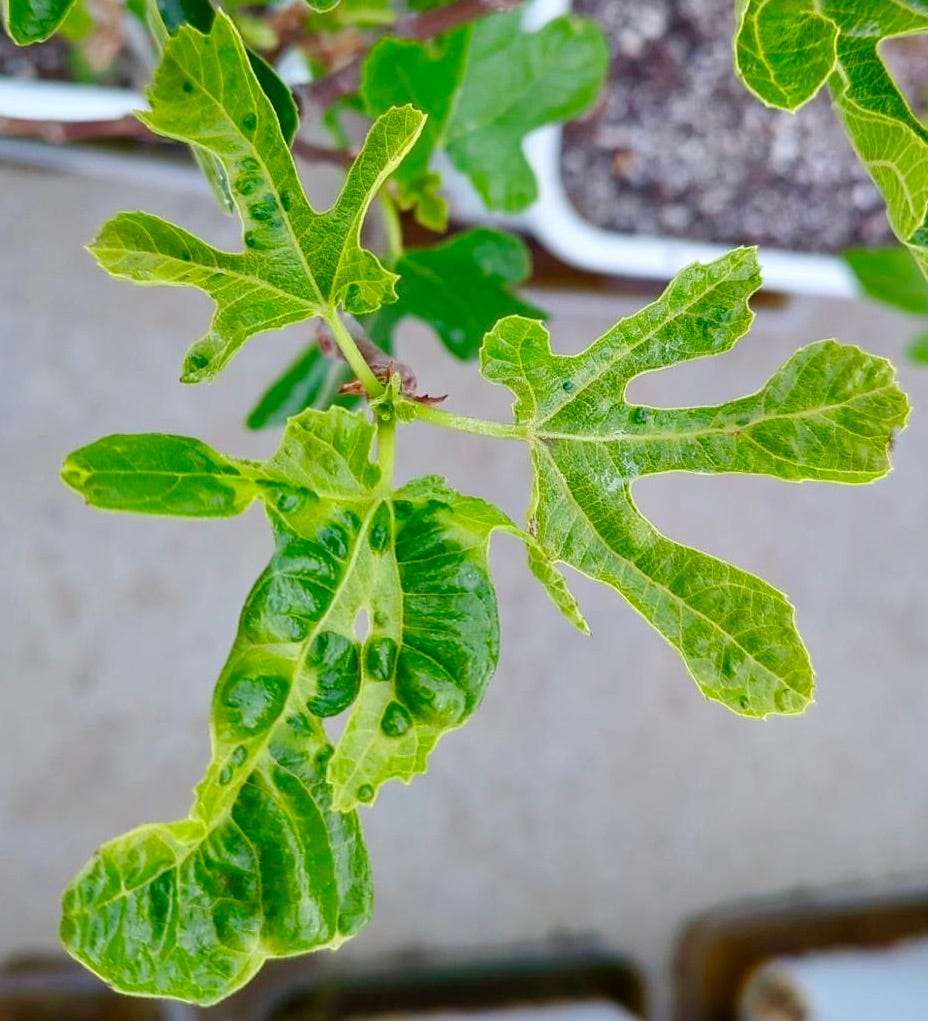
Whenever you are seeing chlorosis throughout the whole leaf with indicators of calcium and/or boron deficiency, it is a good bet manganese is deficient too. Notice they do not have the darker veins associated with iron deficiency.
Sources of manganese:
Manganese is antagonistic to other elements (such as copper, calcium, and iron) and can cause soil deficiencies if added as a soil amendment. It is also very easy for manganese to get locked up in soil. Foliar sprays of reduced or chelated forms of it are considered the ideal method to deal with deficiency. As such, soluble kelp is probably the best option, especially as it also contains boron. The soluble kelp is less likely to cause any toxicities with either element. (Keep in mind kelp is also a source of potassium along with other micronutrients.)
☞ A note about Fig Mosaic Virus (FMV):
There are many who would attribute the symptoms in the above photo to FMV. However, I have yet to see a research study where deficiencies are checked for in connection to FMV symptoms. They definitely were never ruled out or even examined as a causal factor. I have seen more than one research paper on FMV though where the so-called virus was found both in healthy trees and symptomatic trees. There was also a study in which 85 different samples from trees with symptoms attributed to FMV did not have FMV at all and the researchers then assumed that they had nutrient deficiencies. It’s noted that the symptoms were exactly the same. Many longtime fig growers state that trees with FMV symptoms “grow out of it” once proper nutrition is supplied. This indicates that FMV is truly nutrient deficiency.
Being that micronutrients have not been studied in figs, this seems a likely place to start as deficiencies in multiple micros cause deformation and mottled chlorosis. Fig mites, which are thought to be a vector of FMV transmission, would also only bother very nutrient-deficient trees according to the Brix scale of sugar digestibility for insects. Before you say your trees are healthy though, remember fig trees have a reputation for hidden hunger, even amongst the researchers. Insects and any FMV symptoms are visible nutrient deficiencies and are your fig trees crying for help. 🥺 (Poor fig trees, they’re so hungry. 😭)
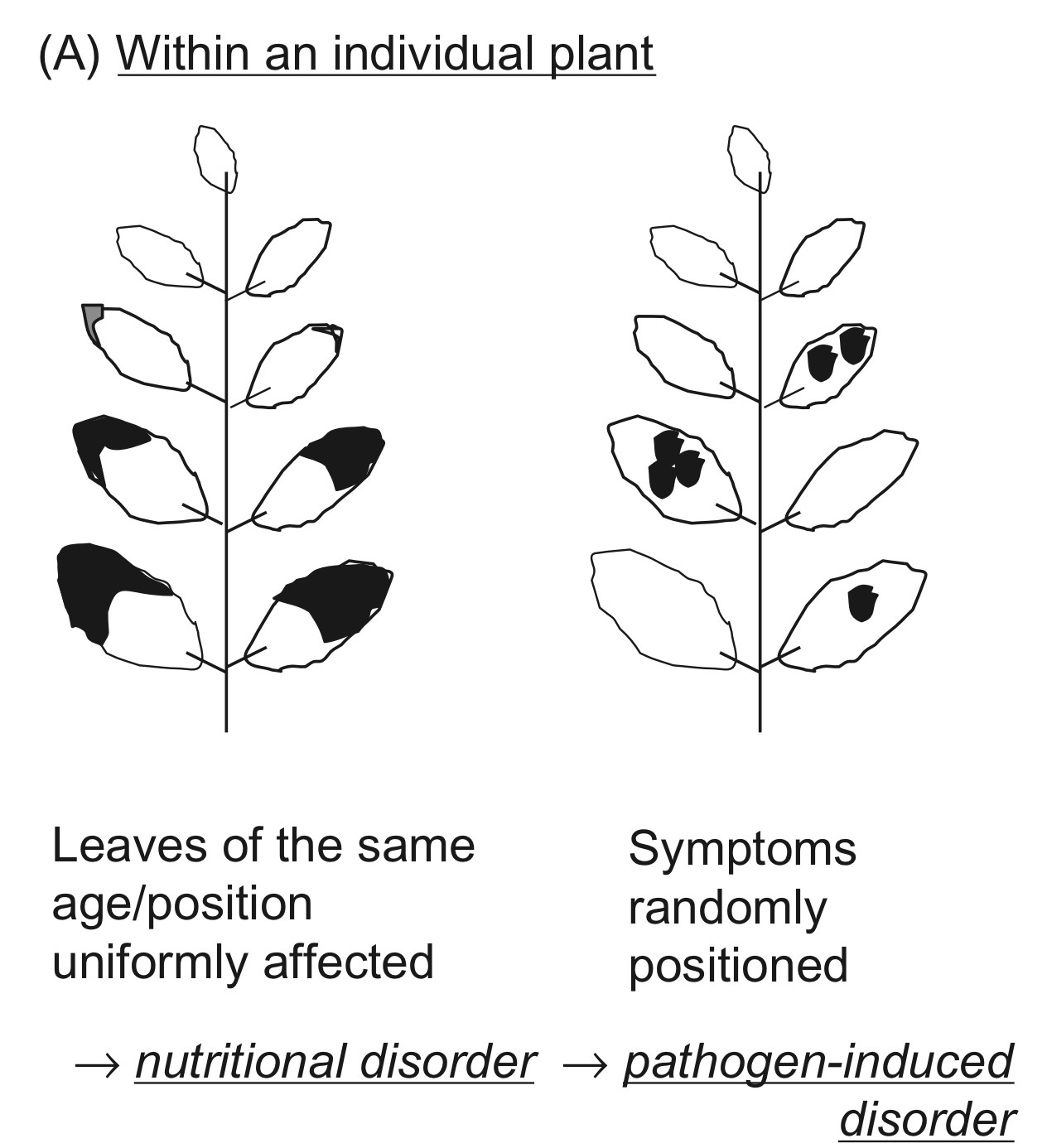
Even though plant health and nutrition have a significant bearing on susceptibility to disease, it is worth mentioning this from Marschner’s Mineral Nutrition of Higher Plants: “In order to differentiate the symptoms of nutritional disorders from these other symptoms, it is important to bear in mind that nutritional disorders always have a typical symmetric pattern: leaves of the same or similar position (physiological age) on a plant show nearly identical patterns of symptoms, and there is a marked gradation in the severity of the symptoms from old to young leaves. In contrast, symptoms induced by the presence of diseases and pests are nonsymmetric or randomly positioned in individual plants as well as within a field, particularly at an advanced phase of infections.”
〉Zinc (Zn)
Zinc is an enzyme catalyst used by a wide range of enzymes in plants. It is also involved with protein synthesis, DNA transcription, cell reproduction, chlorophyll synthesis, ethylene production, superoxide dismutase production, and the plant hormones, auxin and gibberellin. Zinc is critical to many defense mechanisms and water management within the plant. It also has a bearing on leaf size and width.
Zinc is very necessary but also one of the most deficient minerals in soil. Without zinc, growth can be stunted and fruit yields can be lower. Plant immunity is also lower.
Its availability is restricted at high pH and in soils high in carbonates or with large amounts of available phosphorus. Zinc uptake in figs decreases under water stress. Mycorrhizae is very important for zinc availability to plants. Leaf zinc concentrations decrease as the season progresses.
There is only one tiny study on zinc in figs. That study showed zinc significantly improved the fruit sugar content and improved yield. Fruit fructose content increased by 64.5% and 58.5% respectively over the control, the first being a certain amount applied to soil and the latter a lighter amount foliar sprayed. Texture and fruit coloration were negatively affected by the higher zinc applications in this study however, so moderate amounts are recommended.
Deficiency and toxicity:
Soils high in calcium carbonate can cause zinc deficiency. Also soils low in organic matter, alkaline, high phosphorus, or irrigation water high in bicarbonates can cause deficiency. These are similar to the conditions fig trees typically grow in so it is something to watch out for. Stunted trees with tight internode spacing may be a hidden hunger symptom for zinc, especially since zinc helps with growth hormones.
Zinc deficiency is in young to middle-aged leaves starting with yellow and then bleached midribs. Zinc deficiency can look like other deficiencies. In fact, it looks very similar to magnesium deficiency to me. The main difference is that zinc is likely to be in younger leaves first and the interveinal chlorosis appears more bleached to me whereas with magnesium it appears more yellow, but this is certainly not definite.
As stated above, zinc deficiency can happen in soils high in bicarbonate, so if you have been supplying a lot of calcium and magnesium but are having these symptoms, a zinc deficiency is something to consider. Zinc deficiency can also cause leaf distortions in some crops.
Zinc toxicity shows as darker than usual leaves.
There are no pictures of fig leaves with zinc deficiency. So here is a handy dandy image from the internet:
Sources of zinc:
Again we have a winner with kelp. Compost, manure, and plants grown in soils with sufficient zinc are also sources. Zinc can be high in vinegar extractions of dandelion as well. Fermented fish (FAA) and vinegar extractions of the remnants can also be a good source.
Soil pH needs to be below 7.5 for zinc to be available.
〉Copper (Cu)
Copper has not been examined closely in fig nutrition research. Leaf copper concentrations decrease as the season progresses, and that is about it for applicable information here from the fig books and papers.
According to generalized plant information from Regenerative Soil, copper is vital to photosynthesis, redox reactions, protein electron transfer, cell wall and xylem integrity, plant defense, lignin synthesis, and more. He also states: “It’s what makes plants flexible and fruit skin elastic, so it prevents cracking in times of heat stress or unexpected rainfall… Too much is toxic and not enough has serious consequences.”
Deficiency and toxicity:
Deficiency can be caused by an excess of zinc, nitrogen, or phosphorus and shows as chlorosis, dark spots, and necrotic spots on young leaf tips. Some plants show curled, twisted, or cupped leaves depending on plant species. Usually, leaves wilt and eventually drop. This affects young leaves or recently mature leaves. In some cases, deficiency causes die back of stems and twigs leading to activation of lower buds causing excessive branching. Plants can be stunted with short internodes, leaves are usually small, and may have more issue with wilting as copper helps with respiration. Deficiency can also happen in soils high in pH, with high organic matter (mucky soils), in potting mixes high in peat, or in sandy soils. The most frequent deficiencies are due to excess phosphorus.
Toxicity usually only shows when copper fungicides or pesticides have been applied, with sewage sludge, or with contaminated irrigation water. Copper has a role that complements iron and so in toxicity becomes antagonistic to it and causes iron deficiency.
Copper is noted for for its antifungal and antibacterial properties. In some ways, copper deficiency reminds me of leaf rust. In rarer cases, deficiency causes lesions in the bark and produces gummy substances, which reminds me of bacterial canker. It’s ironic since since copper is noted for helping with both of these issues and deficiency does increase susceptibility to disease.
Sources of copper:
Kelp! Of course, it’s kelp like so many of the micros, and it will provide soluble forms of copper. BioAg TM-7 or CytoPlus are also sources. Ironically, the FPJ that reported the highest amount of copper was fig FPJ.
Back to index
Critical points of influence
Have you heard of “Critical Points of Influence” before? There are certain key times of influence in fruit trees for when they are storing nutrients and when those nutrients affect important times of growth. John Kempf has talked about this on his YouTube channel and I felt certain aspects worthwhile to share here translated in my best way to figs.
Bud Initiation: Late Summer/Fall 🍁
(Roughly October/November depending on your climate.)
It may seem odd to start with the end of a season, but actually everything in the following season starts with fall loaded nutrients. Vegetative and fruiting buds form on fig trees during late summer and fall. Nutrients at this time are going to affect the quality and number of buds as well as the stored energy in them. These nutrients may also affect breba quality. It is a critical point of influence in the 2-3 weeks before the tree is getting ready to go into dormancy, as leaves are getting ready to fall (senescence,) because nutrients are being stored by the tree that will be used for intial growth in spring. These nutrients are utilized by the plant before we ever become aware of activity, so it isn’t something we can catch in early spring. We want to ensure an abundance is at the ready to influence this growth.
This means in fall we want to foliar spray or otherwise ensure nutrients are ready and available for the plant to uptake and store so that we can load these buds. This is also the time when we can supply nutrients that help with freeze protection. Urea is recommended for non-organic growers because of its salt content which helps to prevent freeze. For organic growers, urine or sea salt sprays could be possible alternatives. Sugar is also known to help with freeze protection, so having high Brix plants is very helpful for preventing cold damage. A limited application of amino acids can also be applied at this time for plant storage.
A fall dose of soil applied microbes, such as EM-1 or JMS, will help to break down any organic matter, such as leaf matter or granular nutrients, throughout dormancy and will help to neutralize any “pathogens”.
These are the necessary nutrients that will have an influence on bud count, quality, and size, cell division quality, and leaf size the next season:
Calcium
Manganese
Boron
Zinc
Copper
→ Foliar spray water-soluble calcium and seaweed; or do a fall application of soil-applied granular calcium and kelp. This is also a time you might want to give a limited application of amino acids, such as fish amino acids (FAA) or fish hydrolysate.
Alternative: If you prefer purchased mineral products, use gypsum and consider BioAg TM-7 or CytoPlus. Fox Farm Bushdoctor Boomerang also has many of these nutrients.
Vegetative: Bud Break Through Early Summer 🌱
(This happens in mid-March through to May/June in my location.)
When a fig tree wakes up from dormancy, it is going to put on a lot of vegetative growth. It is also going to form fruiting buds for the current year. As such, many of the nutrients needed now are the same as the previous point of influence. This is especially so if you pruned off the wood with nutrient stores over winter. This is the primary period where nitrogen is needed and its use will taper off here as well. Excess nitrogen is known to poorly affect fruit quality, so keep this in mind for any breba crops which are forming during this period. Let nitrogen taper off and don’t use excessive amounts. Calcium is our main driver for quality growth and we want to get it into the system as quickly as possible and maintain it throughout the season.
Now is a good time to help “wake up” soils with microbial inputs, especially focusing on mycorrhizal fungi. We also want to give them a food source with some compost and/or wood mulch. These microbes will help to break down any soil-applied granular nutrients and make them plant-available. We can also do a couple of foliar sprays of microbes to help wake up the phyllosphere (fungi and bacteria in the plant canopy.) EM-1, JMS, or LABS can be good for this.
These are the nutrients that will have an influence on bud count, quality, and size, cell division quality, and leaf size:
Calcium
Manganese
Boron
Zinc
Copper
Nitrogen
→ Foliar spray water-soluble calcium and some early spring applications of seaweed. Fall/winter soil-applied granular calcium and kelp is going to have the most benefit here at the start but another application should be made early for later spring growth. This is also the time to regularly supply fish amino acids (FAA) or fish hydrolysate as a nitrogen source. Grass/weed JLF can also be used at this time.
Alternative: If you prefer purchased mineral products, use gypsum and consider a few applications of Fox Farm Bushdoctor Boomerang or Microbe Brew along with or before changing to a purchased fish hydrolysate. BioAg Cal-Mino or GreenGro Green Aminos are really good at this time too as an alternative to gypsum and other nitrogen products.
Cell Division: Phase I Into Phase II of Fruit Growth 🌸
(For main crop, this generally occurs around mid-May through June in my area, also known as fruit set.)
Phase I of fig fruit growth happens just prior to when you see ostiole scales on a tiny fruit bud form and goes up to its initial size where it pauses in growth for stage II. This is the initial rapid growth stage of fruit when cells are forming and dividing quickly. (Stage III is when it resumes growth and gets ready for ripening.) This period in figs can last for several weeks and has significant influence on the final quality of the fruit. We want to limit or really control potassium in this period because it affects how much calcium can be used for cellular quality. This is also the signal to begin tapering off nitrogen.
These are the critical nutrients for cell division and quality:
Manganese
Calcium
Boron
→ Foliar spray or soil drench with vinegar-extracted oyster shells, vinegar-extracted fish bone remnants from FAA, or vinegar-extracted crab shells.
Alternative: If you prefer purchased mineral products, consider something like BioAg Cal-Mino and TM-7.
*Be mindful that all of the above contain a certain amount of nitrogen.
Fruit Fill: Phase II and Phase III of Fig Fruit Growth 🍏⇢🍎
(Typically occurs for main crop from mid-June through October in my climate.)
Kempf’s fruit fill period overlaps with Phase II, but is especially picked up in Phase III.
Phase II of fig fruit growth shows no visible changes with the fruit remaining the same size, color, and firmness as the end of Phase I. There are things going on the inside though. Phase II is building dry matter with total pectin, cell firmness, and acidity, which makes calcium important. Phase III of fig growth starts with a rapid change in growth, color development, and pulp softening, which makes potassium important.
In the fruit fill stage, we can influence the quantity of sugars in the fruit and the quantity of sugar produced in the leaves from photosynthesis. Potassium is directly linked to the amount of carbohydrates and the amount of sugar in a fruit, so this becomes an essential element at this time. We want to maintain a balance of calcium and potassium throughout this period. Copper helps with skin elasticity which helps to prevent splitting.
Critical nutrients needed for fruit fill:
Potassium
Calcium
Manganese
Zinc
Boron
Copper
→ Foliar spray or soil drench with fig fruit FPJ or continue using water-soluble calcium and seaweed. Alternatively, gypsum, langbeinite, and kelp/seaweed can be used instead and should be applied before needed if using granular.
Alternative: If you prefer purchased mineral products, consider using a water-soluble Cal/Mag product along with BioAg CytoPlus. GreenGro Nature’s Brix can also be used to boost potassium.
Ripening: End of Phase III of Fig Growth, Managing Ripening 🍃
This is the very end of Phase III of fig fruit growth, as we are getting close to the ripening point. At this point, we can influence color, aroma, flavor, and other quality characteristics. In Kempf’s points of influence, this also relates to end-of-season harvest. Numbers 1 and 2 listed below are for the end of the season; 3 is for ripening at any time.
We can influence senescence (dormancy/leaf fall) to a degree in some plants by the micronutrients applied. I haven’t tried this myself in figs, but felt it was worth mentioning in case any would like to try it as I know timing can be important for those growing in colder climates. Boron speeds up the rate sugar is moved into the fruit. So if we have a crop we want to speed up the harvest of, apply a strong foliar application of boron (within plant limits, not toxic levels) and it will move the sugars quickly from the leaves into the fruit or grain. This is something to do as a last harvest as the season is ending and can reportedly be used to trigger dormancy. This only works with the plant’s natural rhythms to speed up what it is already getting ready to do, meaning you can’t trigger dormancy in a fig tree if we’re still in the middle of summer. This only speeds up plant processes that are occurring naturally.
The exact opposite is done with cobalt which limits the production of ethylene. Cobalt delays senescence and keeps a plant greener longer and it can keep fruit on the plant for a longer period of time. Generous applications of cobalt slows down maturity.
Nitrate can really interfere with proper fruit ripening and maturity. Magnesium, sulfur, and molybdenum are mentioned to control nitrate during the ripening stage to aid with fruit quality.
The key nutrients to manage for ripening are:
Boron, higher end foliar application (to speed up ripening)
Cobalt, higher end foliar application (to delay ripening)
Magnesium
Sulfur
Molybdenum
→ These nutrients are a bit more specific in purpose and are used as needed. Continue nutrients from the fruit fill period above if not wishing to influence ripening time. Langbeinite is good for magnesium and sulfur and is a nice addition as we get to the ripening stage, (it also contains potassium which is still beneficial at this stage.) Seaweeds can have a high level of cobalt, so we may want to stop using seaweed at this time to avoid potentially delaying ripening. It’s iffy to say if it is high enough to cause that issue, but something to keep in mind if you are experiencing problems.
Timing of granulars:
When do you apply granulars to your soils and potting mixes? Do you give them enough time to be broken down or do you apply them at the moment the nutrients are needed? 😀 (Well, better late than never, I suppose.) It’s important to understand that any soil-applied granulars need time to break down to become plant-available. Some take about a month to start becoming available, others can take a year or more, such as eggshells or seashells. Gypsum takes 45 days to really be available and lime, while quickly raising pH, can take about 6 months to be plant-available. While figs do really like lime, be mindful that the higher soil pH it causes can limit the availability of other minerals that need a lower pH. So it is better to apply it in the fall if using it for calcium where the pH effects can start to drop off by mid-spring.
Microbial life and soil acidity have a bearing on how fast these break down as well, and in fact, most soil applied materials are for the point of charging microbes with them to then feed the plants. So if you are wishing to influence a certain period of growth, you need to time applications of granulars at least 1-3 months before those nutrients are needed by the plant. (This does not include compost or worm castings which often have water-soluble nutrients stored and will release them according to moisture.)
You can do things with granular minerals to make them available faster if you missed an application window. Acids will alter them and make the minerals water-soluble. So using vinegar or citric acid can be useful if we need minerals now. I wrote about using vinegar here and Justin Wahler wrote about citric acid here. Remember too that amino acids, such as in FAA, and fulvic/humic acid are good chelators of minerals and can help make them more readily available.
Water-soluble nutrients are typically available immediately and can be foliar sprayed or root drenched.
Back to index
Fertilizer protocols-ish
Were you overwhelmed by the mineral breakdown above? (Maybe bored? I may have put myself to sleep at times, Lol! That is what happens when you use research papers as the basis for an article.) Breaking down each mineral can make it seem complicated, but really it’s not. It’s more about having an understanding of which nutrients to prioritize for figs, particularly calcium. Also, many inputs overlap among the nutrients so choosing ones with the most overlap is helpful.
So now that we’ve talked about all of these minerals, you may be feeling pretty pumped to load up the nutrients in your trees. But it is very worthy to mention the need to prevent excessive nutrient loading in plant and soil. Doing so can create antagonistic responses that end up weakening plant immunity. After all, we are aiming for healthy, nutritionally balanced trees, grown in healthy soil with proper nutrition, with much of it obtained from biology, aren't we? Such a tree can better defend itself and give its best produce.
I suppose you may be hoping for some sort of fertilizer chart and schedule from me. Certainly, well-timed applications are very useful and important. However, there are so many viable options to choose from that to limit it seems unfair. I would rather you apply nutrients according to your circumstances and what you are directly observing in your trees. I’m more about facilitating than dictating. I know some are scared away when they see schedules and lists; others seriously need them. I seriously like my time and freedom and to play mad scientist with my own fertilization practices. 😜 So, how to best help you?
K.I.S.S. 😘
Keep it simple, seriously. Do you remember that in Turkey some commercial orchards only fertilize every 2-3 years? 😀 Well, potted trees are a little different, they need regular nutrients since they don’t have access to an entire soil system. But there is no need to stress or order a bunch of different products. You understand the nutrients involved now, just choose the inputs that interest you or that are easy to obtain. Choose what fits you and your trees best.
The below recommendations are just some simple basics.
🌳 The ultimate one and done fertilizer for fig trees is figs and and leaf litter. That is following nature’s way of returning things to the plant. You’ll notice we were using the values in leaves and fruits to determine necessary nutrients. These already have everything in the right ratios, no guesswork is involved, and can be used throughout the season.
Fig fruits can be used to make fermented plant juice (FPJ) or JADAM liquid fertilizer (JLF.) FPJ smells decent and is in small batches with high dilution; JLF is stinky but good for bulk fertilizer and has lower dilution rates. Take any excess figs, figs that dropped, were bothered by insects or birds, late season fruits that won’t ripen in time, or those brebas you don’t really like and make FPJ or JLF with them. FPJ is also great for rooting cuttings.
Leaf litter is great for mulch and can be broken down if needed with a lawn mower and then applied.
🌳 If you are a fan of Osmocote or slow release fertilizers, consider using one of these instead:
Down To Earth Tree & Shrub (also has mycorrhizal fungi)
Down To Earth Fruit Tree
Down To Earth Palm Tree
Espoma Organic Tomato Tone
Espoma Organic Palm Tone
Espoma Organic Citrus Tone
Dr. Earth Exotic Blend Palm, Tropical, and Hibiscus (also has mycorrhizal fungi)
The above granulars are more suited to fig tree ratios than others. They should be applied spring and fall at the least. However, it is best to apply them a few more times throughout the season if they are your only fertilizer. They do all contain a certain amount of calcium, so you may be able to decrease other applications of it. One of these could stand in for the worm castings or compost mentioned elsewhere if desired.
I am loathe to recommend a Miracle-Gro product. 😑 But if that is all you will use, I recommend only this one: Miracle-Gro Performance Organics Edibles Plant Nutrition Granules.
🌳 For in-ground trees, an application of calcium (based on your soil) followed by compost (or worm castings or manure*) in the drip line and then topped with wood chips every spring and fall is typically all that is needed. (Keep these away from the trunk.) Green mulch can also be used as an alternative to or along with compost and woodchips.
Most in-grounds will develop relationships with microbes in the soil and will have access to many more nutrients than potted trees do. It is more about building up soil health for in-grounds. JADAM microbial solution (JMS) or EM-1 can be helpful to jumpstart this. Regular applications of compost tea or JLF can be very good for this as well. Any other nutrients are applied more as needed to correct visible issues in the trees or because of known soil deficiencies.
You can step it up by adding: Foliar sprays of vinegar extracts and/or FPJs.
*There is a caution with manure: many manures are now contaminated with herbicide residues from the feed given to animals. These can negatively affect your gardens and plants. They are persistent and may take years to get out of the soil. Please be very careful when using manure, especially from horses or cattle or anything that is fed hay, grasses, or grains. It is good practice to test out any manure by using it to sprout beans & seeing how they grow before applying it to your yard. Most manures should be aged before applying to plants.
🌳 For potted trees, nutrients can wash out of the pots because they do not have a large soil battery to hold onto them. Also, the root structure is much smaller and tightly contained so they are not able to reach out to different areas looking for nutrients. Potting mixes themselves are also often very deficient in minerals, unlike soil which is mostly mineral. So we want to ensure a regular supply of plant-available minerals to make up for the lack of soil interaction. This means it can be preferable to have them in forms already broken down and usable.
▹ BASIC SCHEDULE FOR POTTED TREES:
Bud break: Apply calcium of choice, seaweed, and FAA (or fish hydrolysate)
Spring: Calcium and FAA (or fish hydrolysate)
Late Spring/Early Summer for fruit set: Calcium & BioAg TM-7
After fruit set (once they hit about grape size & pause) through ripening: Calcium, seaweed, and langbeinite (humic acid can be added as a chelator if desired.)
☆ STEP IT UP BY ADDING:
Bud break: Top pots with worm castings or compost, and mulch* of choice; or just use Kellogg All Natural Garden Soil as mulch. Basalt or other rock dusts can be added now as well.
Foliar spray or apply to soil as desired: Vinegar extracts, FPJs or JLFs, compost teas, and/or microbial inputs (EM-1, LABS, JMS, etc.)
*Keep any mulches or compost/worm castings away from the trunk of the tree.
The maximum frequency of application for the homemade liquid inputs mentioned above is about once a week, the minimum is about every three weeks, always diluted. Otherwise, follow the directions on the bottle or package if using a commercial product.
🌳 Additions for extra credit:
Add a mycorrhizal product at the start of the growing season, especially if potted.
Compost tea is great for many things, for in-ground or potted!
Blackstrap molasses is a nice addition for micros, potassium, and to increase Brix, especially with any calcium foliar sprays during stage 2 & 3 of fruit growth. It can be a swap for seaweed at times and will help feed microbes in the soil.
Add basalt sand/dust to pots periodically for micronutrients and to increase Brix.
Use JADAM Microbial Solution (JMS), diluted raw whole milk, LABS, or EM-1 at the start of the season to boost the microbes and whenever there is a pest or disease type issue. It is also handy to apply it whenever adding organic matter or mineral content to help break it down.
There are so many options, right?! It seemed complicated to list them all but criminal to not let you know what’s available. The good news is that this allows you to find what is accessible in your area and price point. Let your time and ability be your guide.
For myself, I have a tendency to rotate things as opposed to sticking to one thing. I apply what seems intuitively right at the time. And with rotation, I feel it gives more opportunity for anything missing to be picked up somewhere in there. I always have a microbe input, JLF, FAA, and vinegar extractions on hand and usually some seaweed product. Sometimes I will add in new products that catch my eye. This year it is BioAg Cal-Mino and CytoPlus that I am trying out. I do a lot out of curiosity, and so if I listed everything I do, it would seriously make it seem much more complicated than it is in reality. 😆
I am focusing A LOT on foliar sprays this season as part of my attempts to deal with BFF. Last year brought some personal complications and I neglected my trees as a result. So this year I am starting with a nutritional deficit for which I’m trying to make up. I rotate the most with foliar sprays, whereas what goes into my fertigation unit remains fairly constant with FAA and JLF. I probably will always foliar spray with soluble kelp though, I think that will be a regular after going through those micronutrients.
Back to index
Conclusion
We are at the end friend. Do you feel it helped at all in understanding fig specific nutrients? I really hope it did, that’s the goal here!
Because of a little pest, I was finally impelled to go beyond my initial research of the plant I was trying to grow, and I can’t be more appreciative for that. Through figs, I have grown in entirely unexpected ways. Now I hope for yours and mine to grow infinitely better. They should after all of this reading you’ve done here— now go outside and get to tending your figs!
Happy fig eating this summer to all the readers here!



